France
Paris
Switch to your local agency
Retour au menu
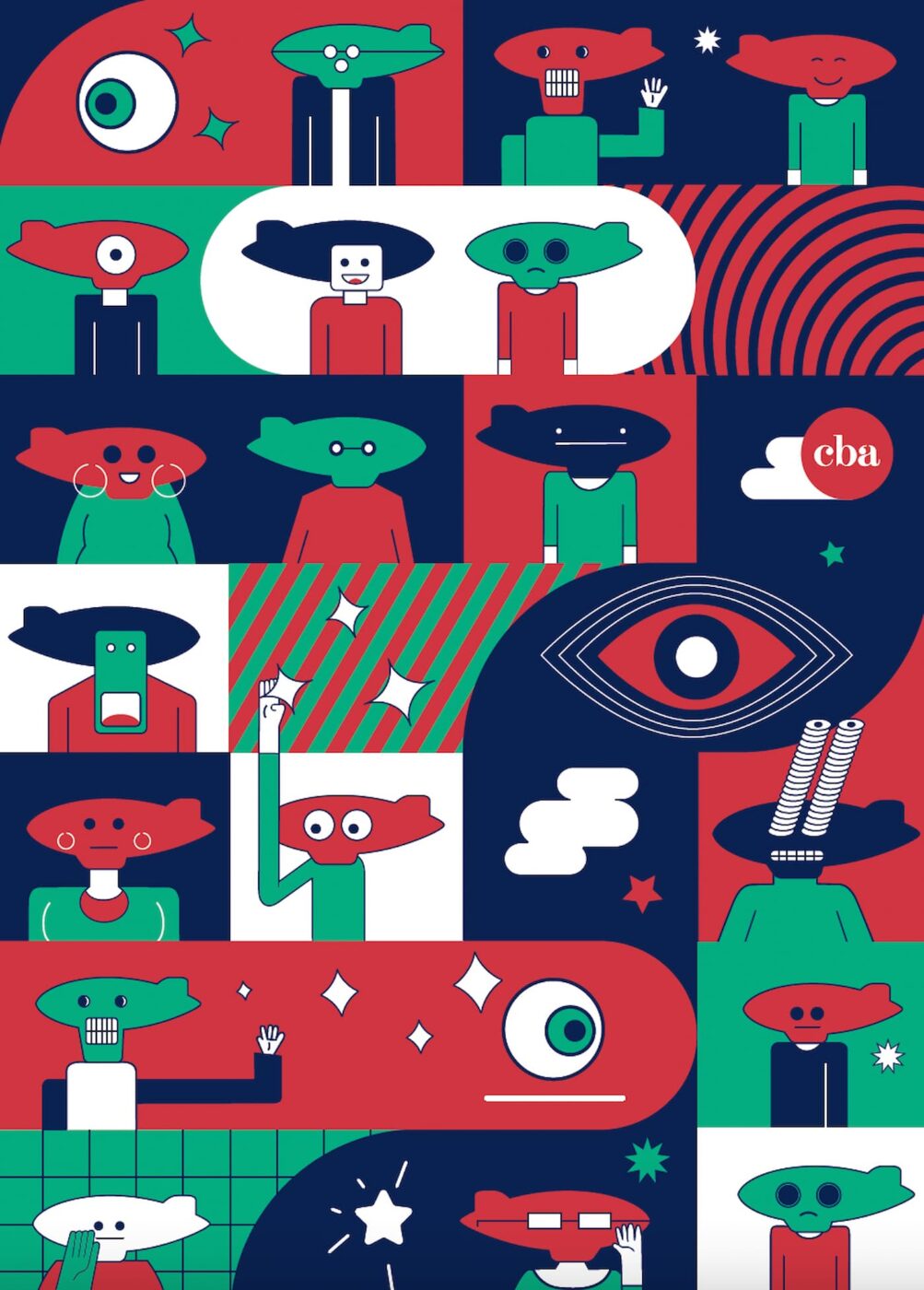
In 2022, The Good Company and the study institute Kantar launched the Inclusion & Diversity in Advertising barometer.
The goal? « Confronting the perception and expectations of the French people with the reality of advertising content ».
72% of the French consumer think that « showing diversity in advertising is important, even very important ». It’s a high number that shows that the population wants to see more inclusive advertising that celebrates diversity. The consumer changes, evolves, and becomes more and more uncompromising towards brands. He is looking for brands that represent its values.
According to a study carried out by Environics Research and Amazon Ads, 72% of American consumers and 60% of Europeans consumers « aspire to more diversity and representation in advertising ». Thus, between the consumer and the emergence of cancel culture, brands must react.

In 2022, The Good Company and the study institute Kantar launched the Inclusion & Diversity in Advertising barometer.
The goal? « Confronting the perception and expectations of the French people with the reality of advertising content ».
72% of the French consumer think that « showing diversity in advertising is important, even very important ». It’s a high number that shows that the population wants to see more inclusive advertising that celebrates diversity. The consumer changes, evolves, and becomes more and more uncompromising towards brands. He is looking for brands that represent its values.
According to a study carried out by Environics Research and Amazon Ads, 72% of American consumers and 60% of Europeans consumers « aspire to more diversity and representation in advertising ». Thus, between the consumer and the emergence of cancel culture, brands must react.

In 2022, The Good Company and the study institute Kantar launched the Inclusion & Diversity in Advertising barometer.
The goal? « Confronting the perception and expectations of the French people with the reality of advertising content ».
72% of the French consumer think that « showing diversity in advertising is important, even very important ». It’s a high number that shows that the population wants to see more inclusive advertising that celebrates diversity. The consumer changes, evolves, and becomes more and more uncompromising towards brands. He is looking for brands that represent its values.
According to a study carried out by Environics Research and Amazon Ads, 72% of American consumers and 60% of Europeans consumers « aspire to more diversity and representation in advertising ». Thus, between the consumer and the emergence of cancel culture, brands must react.
According to a study carried out by Environics Research and Amazon Ads, 72% of American consumers and 60% of Europeans consumers « aspire to more diversity and representation in advertising ». Thus, between the consumer and the emergence of cancel culture, brands must react.
Brands’ authenticity is regularly questioned or pointed at. Are some brands legitimate? Authentic?
What brands are being criticized for is the lack of concrete proofs. A simple speech is not enough. It must be supported by actions.
————– Environics Research and Amazon Ads
Many brands are engaging in what is known as brand activism, i.e. the commitment of a brand, in a concrete way, to a social or environmental cause.
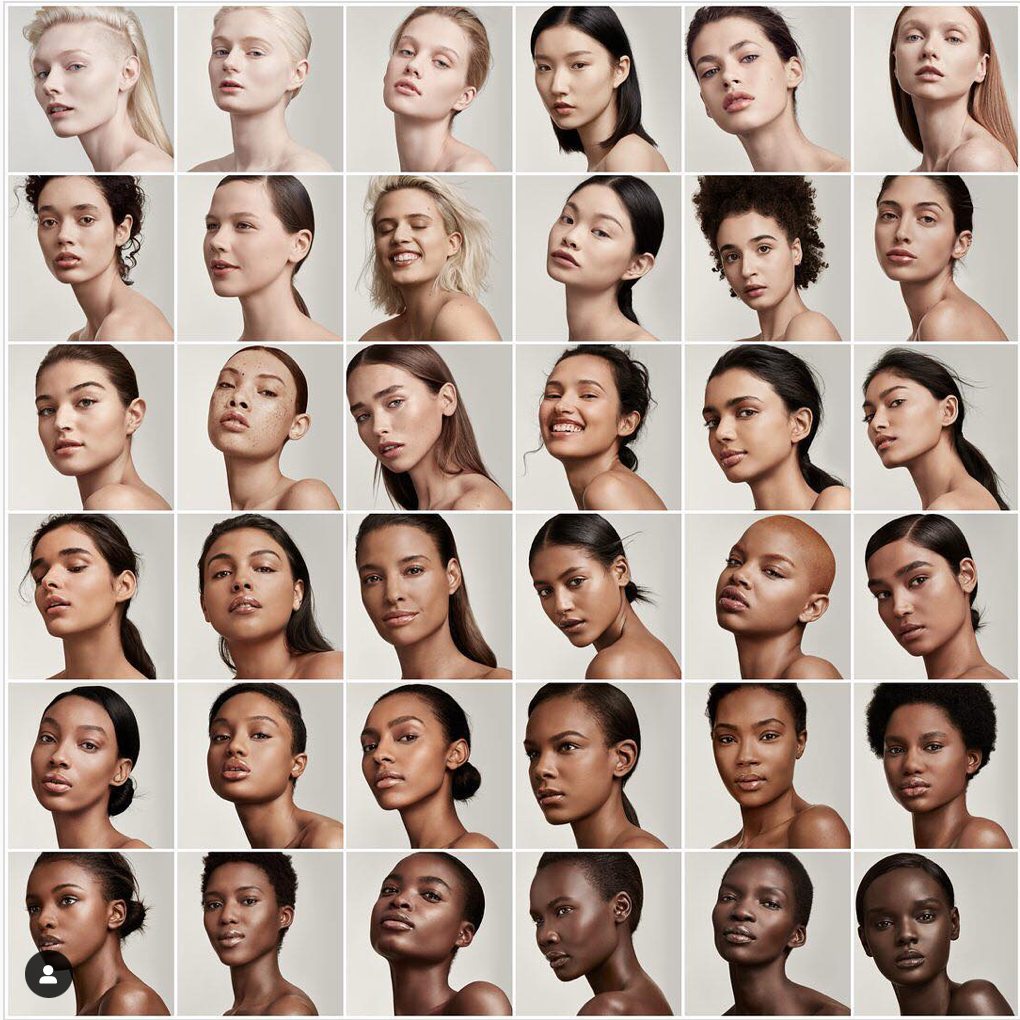
A concrete example is the brand Fenty Beauty, who launched more than 50 shades of foundation, in a market where it’s still difficult for black people to find a make-up product that matches their skin tone.
A concrete example is the brand Fenty Beauty, who launched more than 50 shades of foundation, in a market where it’s still difficult for black people to find a make-up product that matches their skin tone.

Gillette decided to question men stereotypes through its campaign called « The man your are » by highlighting a diversity of men when shaving. The goal? Break the codes. Gillette, in making that choice, wants to allow all men to feel represented when watching this ad.
The opulent expression of glamour & feminity has become dated and Lux has understood it well. The brand wanted to inspire women to rise above everyday sexist judgements & express their beauty & femininity unapologetically. Our teams redefined the brand’s purpose and accompanied Lux on the creation of its brand visual identity.
« Creative and developer, great artists, great feminists, big mouth, big heart (…) » … SNCF, the French public railway company, launched « Hexagonal », a video campaign, with the goal to federate its users by representing them through its advertising. A campaign rewarded by a Bronze Lion in the « Creative Strategy » category (Lion Cannes Creativity International Festival). A campaign to support the business plan launched in 2020 by the SNCF, which focuses on putting people at the heart of company, the development and vitality of territories, the ecological transition and digital mobility.
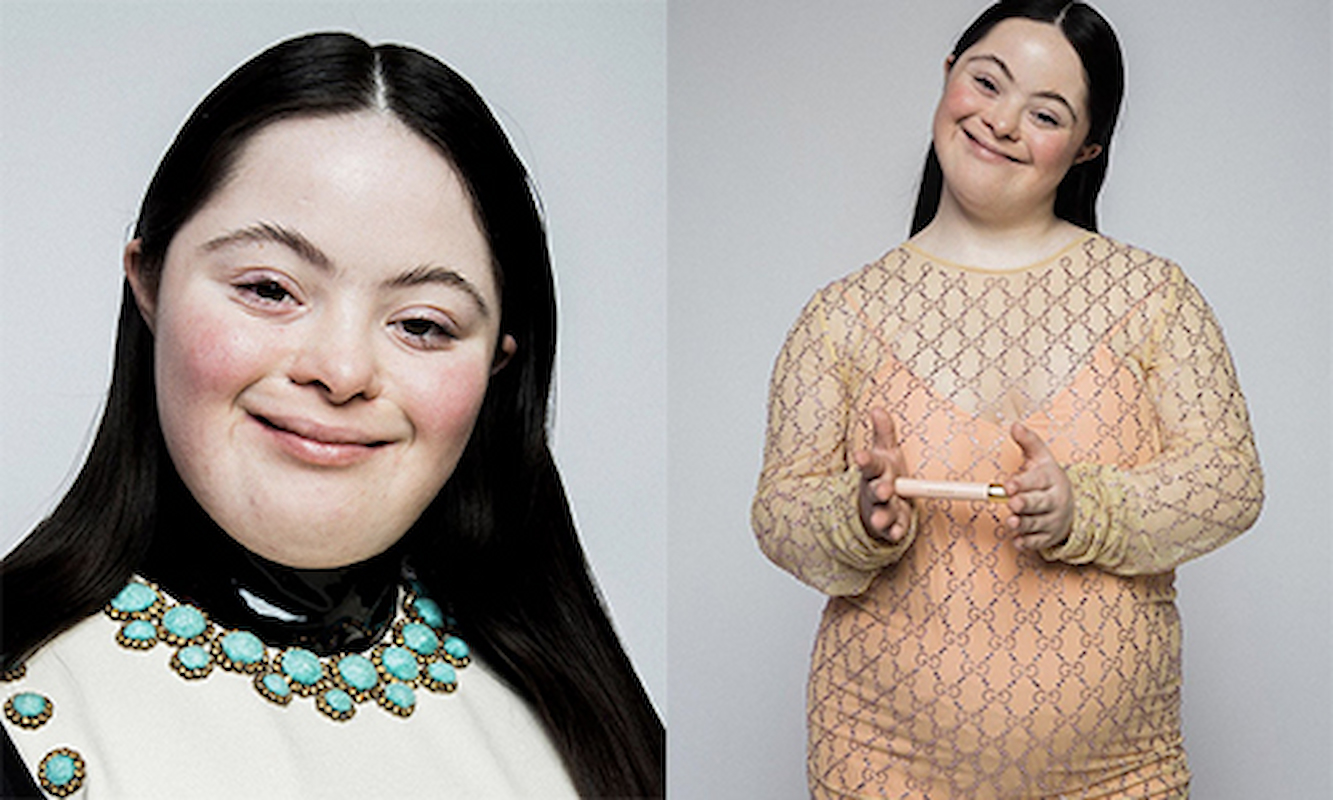
In 2020, the iconic luxury brand Gucci has chosen to appoint as the muse of its brand Ellie Goldstein, who has Down’s syndrome.
A bold choice since the market is still very stereotyped and standardized.
Gucci highlighted the effort to be made by the brands and denounced the lack of representation in of the market.
In 2020, the iconic luxury brand Gucci has chosen to appoint as the muse of its brand Ellie Goldstein, who has Down’s syndrome.
A bold choice since the market is still very stereotyped and standardized.
Gucci highlighted the effort to be made by the brands and denounced the lack of representation in of the market.

Other brands make the choice to rebuild completely their naming or visual identity. It’s the case of Aunt Jemina, which changes its name to Pearl Milling Company and erased the image of a black woman from its packaging ; caricature of the black nanny caring for the children of a white family.
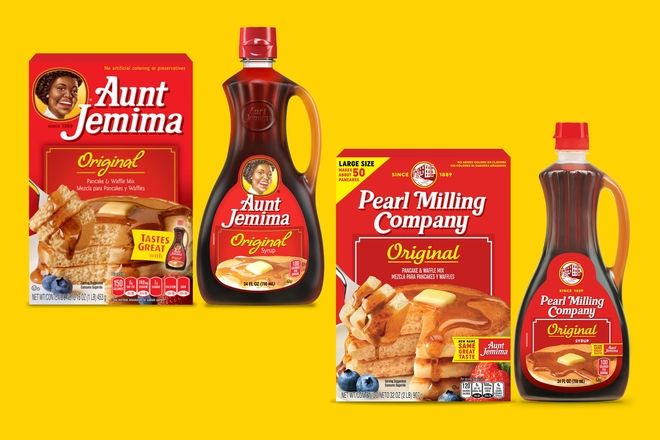
The COVID-19 pandemic has changed consumption and buying habits like never before. Consumers expect more and better from brands. Clients and brands alike have had to rethink the way they approach retail spaces. Today, a brand must not only create a retail space but think it, design it and give it meaning. We might think that e-commerce has put a strain on retail but, rest assured, this crisis has given birth to a lot of new perspectives for retail design.
To this day, it’s still difficult for retailers to get customers back into stores due to safety and security concerns. But on the other hand, consumers are storming into stores as a sign of a return to normal life. However, a new era is emerging. The era of Retail 3.0. The one where the consumer is in charge, where people understand that they have the power to make brands understand their needs.
Retail is no longer just about selling a product in a physical store, it is also about building a relationship between a brand and its audience.
Consumers no longer only want to be sold a product, they want to establish and build a real relationship with the brand. How? Through experience.
Customers are looking for experiences. Experiences they can’t get online. They want to be able to make it worth their time to go there. And it’s through design, that a brand can craft those experiences and meet that need, in whatever way possible. To do this, you must be able to project yourself. Question yourself and ask yourself: How will this space be crossed? What will the visitors feel? What will they experience? What is the attraction, beyond the products on sale? It is by answering these questions in an agile, realistic and relevant way that a brand can design experiences within its retail spaces.
How can you think about in-store experience without considering digital? Today, we have a lot of devices and tools at our disposal to bring to life experiences that take full advantage of new technologies. Digital can allow a space to exist beyond its limits. And this, by gathering and uniting in the service of experiences for well-being, for play, for learning.
Let’s take the Nike brand as an example. Fully turned towards the future and focused on digital, the brand has launched a brand new retail concept: the House of Innovation. Located in Paris, this store offers an immersive and digital journey from start to finish to its visitors. This is illustrated in particular by the installation of a control wall at the entrance, an interactive play area via terminals for children and many others…
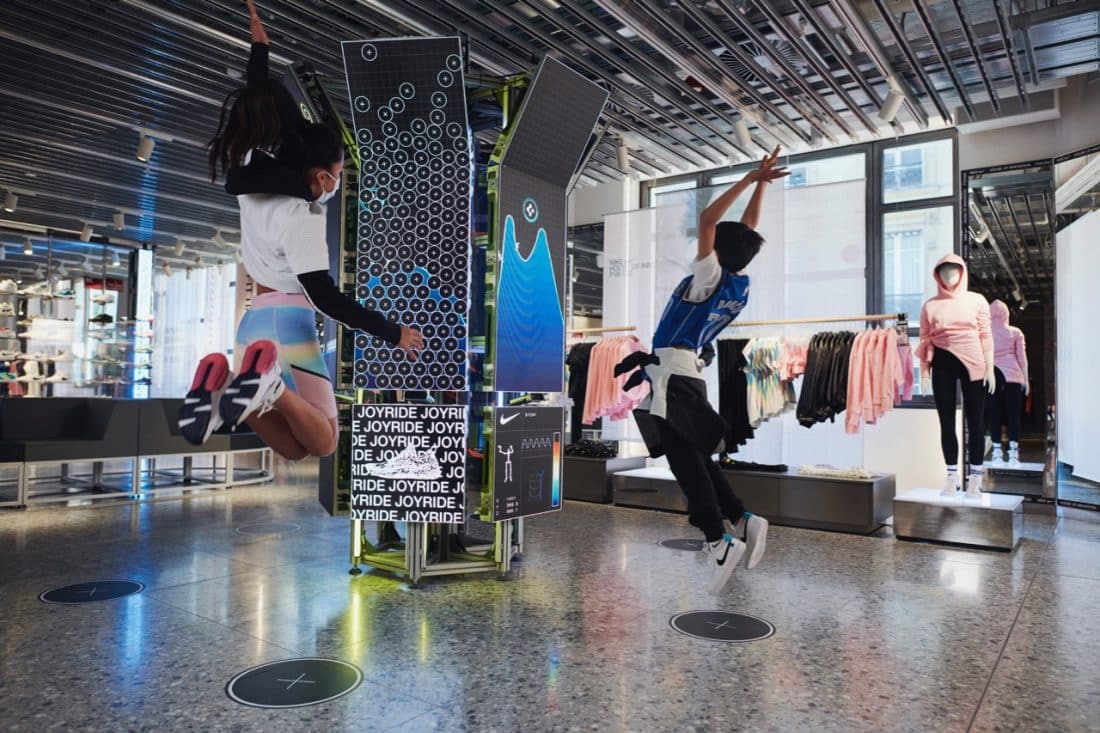
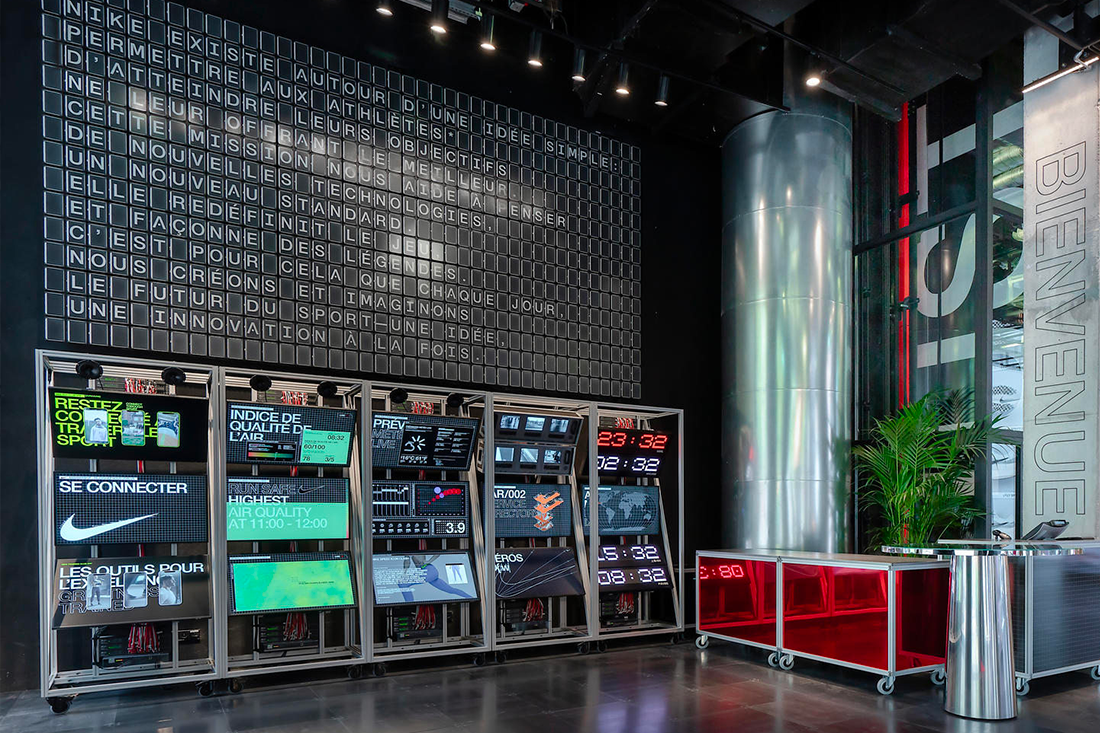
However, technology also has its limits. It should not be perceived as too intrusive and suffocating for customers. This is why it must be approached subtly, and not be placed in the foreground in a too direct way, but in the background.
With digital, brands can create magical experiences. Experiences where customers could feel like the space was designed especially for them. A place where they can feel good and that, of course, will make them want to come back. The brand can also see its benefit. By creating connected experiences within its spaces, it generates traffic to serve its strategy.
New technologies have given retailers a playground of limitless possibilities, and we are still far from seeing the end of it.
It’s not news, we are facing the biggest environmental crisis our planet has ever experienced. Beyond the implementation of CSR policies, brands must design retail spaces that respect the environment. Spaces with meaning, which will invite us to reflect and rethink our buying habits.
There is a real opportunity for brands to design for our collective future. This includes flexible and responsible spaces. But it is also illustrated by measures put in place to rethink the way we consume. For some brands, this will be the installation of refill stations within their spaces. Stations in order to refill our products (liquids, bulk…) rather than buying a completely new one which will consume much more plastic. This is the case for L’Occitane, which has installed refill fountains in more than 58 stores around the world. Retailers are also getting involved, including Monoprix, which has extended its refill service to other major grocery brands: Barilla pasta, salted biscuits Michel & Augustin, Krema et Lutti gummies… For other brands, it can also be spaces specially designed to allow their customers to give a second life to their used products.
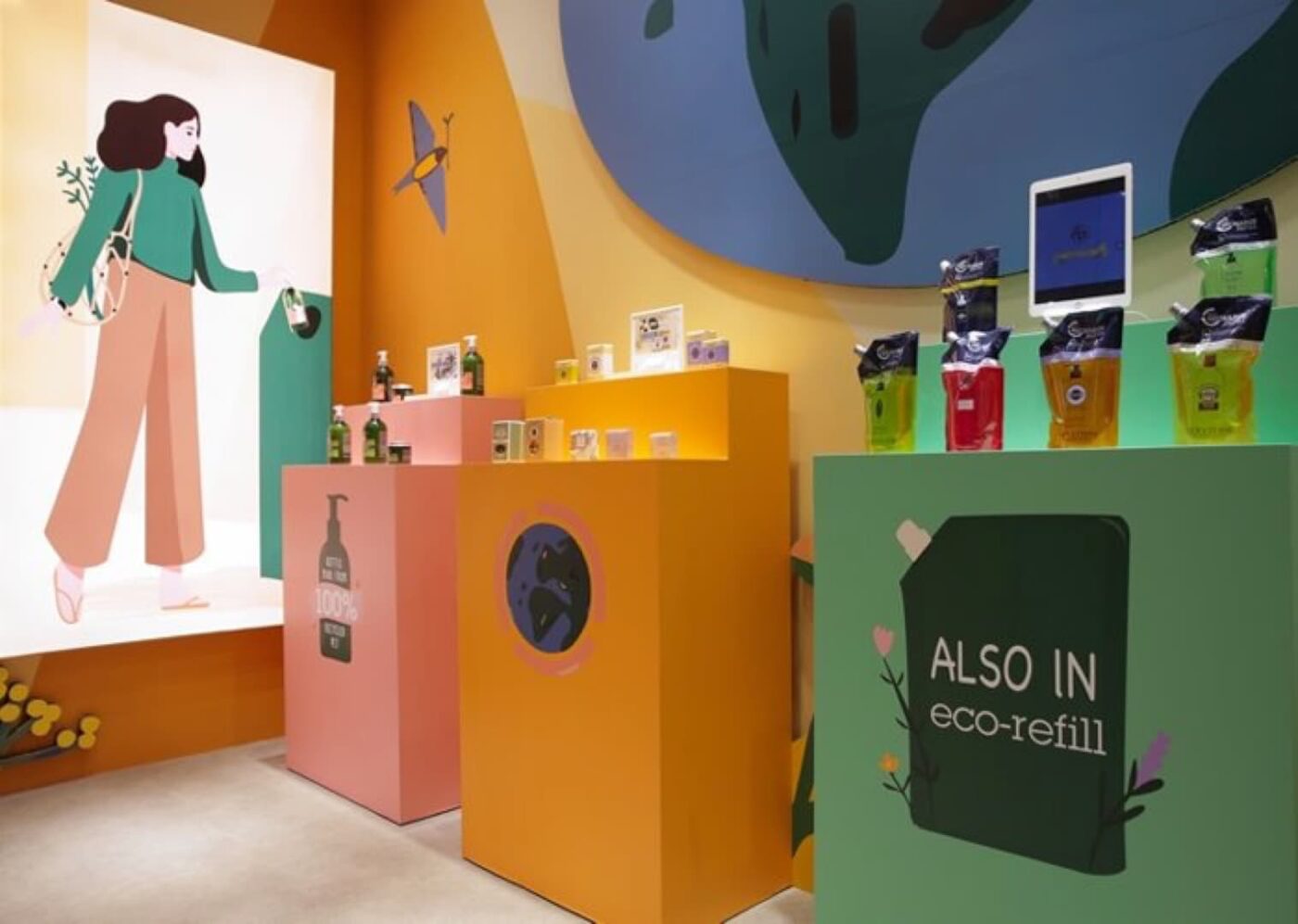
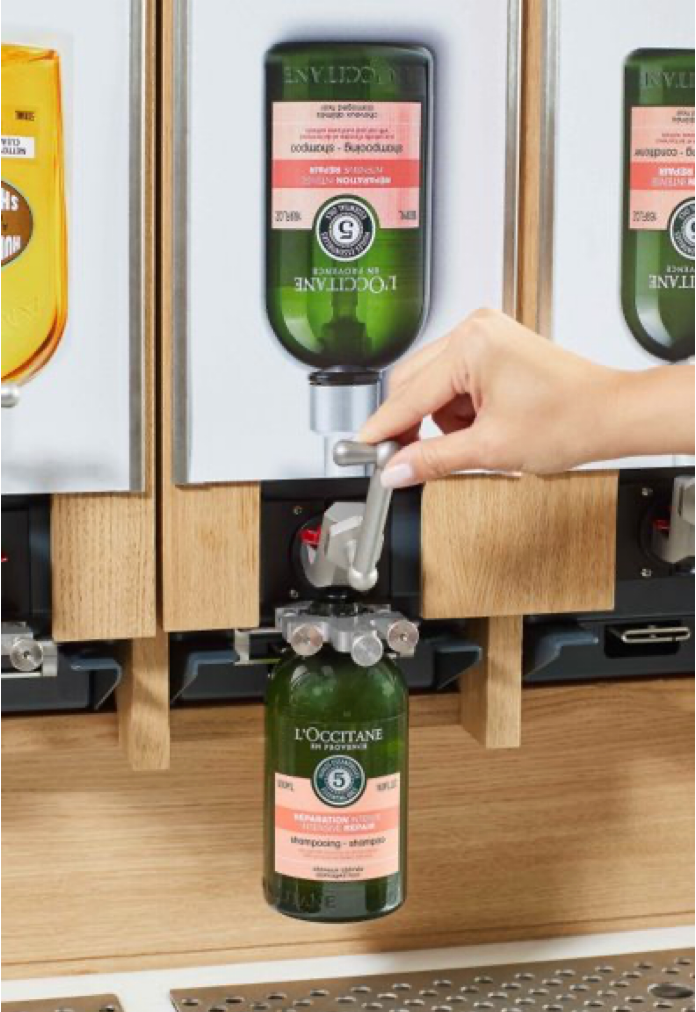
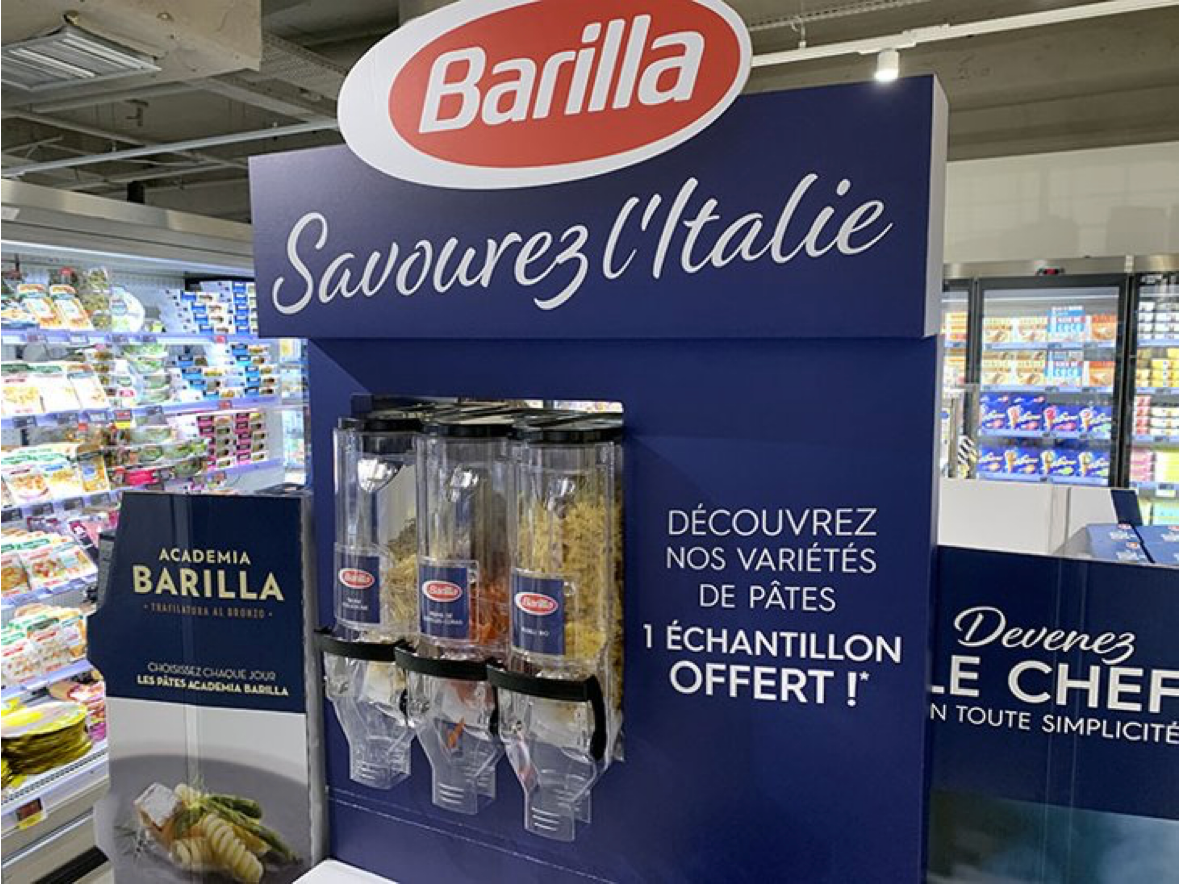
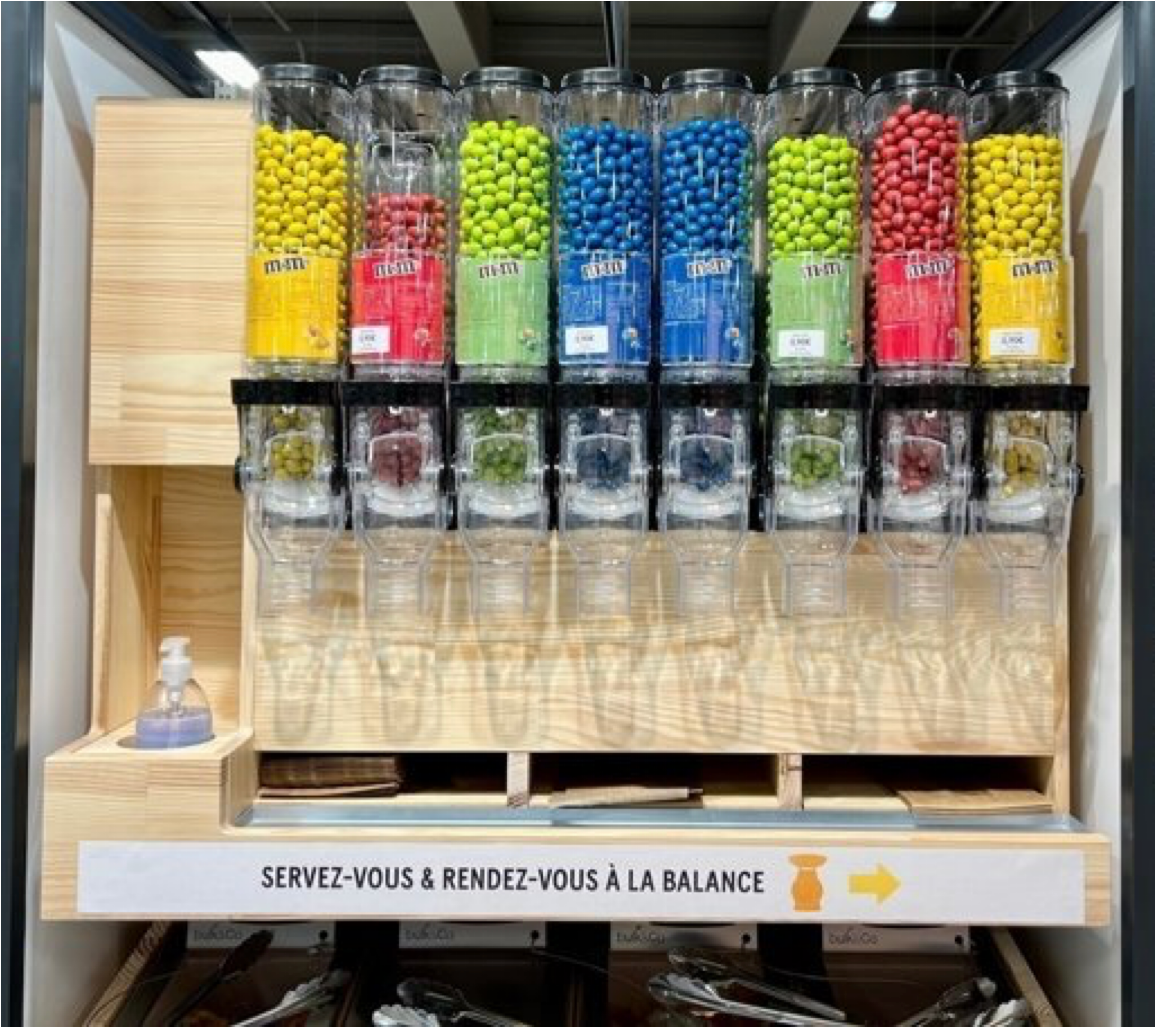
Finally, the retail space itself needs to be rethought. Because yes, the realization of retail spaces has a strong impact on our environment. It is therefore essential to integrate this aspect into the design of a project. The design as well as the materials used must be, as much as possible, respectful of the environment. This is not just another constraint for brands, but a real way to act and create value.
One thing is certain: the global pandemic did not mark the end of retail spaces. On the opposite, in fact. A second life is presented to it. A second wind to perpetually renew and reinvent itself.
Now more than ever, we designers and retail actors have a role to play in protecting the environment and our planet. Construction sites and creation of retail concepts massively pollute and affect us. They are damaging our landscapes, our land, our water… For instance, the construction industry produced 6 million tons of waste per year in France in 2020. The construction sector also extracts more than 30% of the planet’s natural resources, worldwide.
At CBA, we place great importance on the fact that our creations are above all THOUGHT.
Beyond being well designed, well drafted and achievable, a project must above all be respectful of the environment. This aspect, which we integrate into all our projects, was reinforced in 2019, when we collaborated with Malongo (a French company known for its fair-trade coffees) to reposition the brand through its retail stores. Besides the use of sustainable and organic materials, and the design of disassembled furniture for easy recycling, we had established a dense sustainable development specification so that the entire project would be carried out in a responsible and committed approach. This collaboration has allowed us to adapt our creative process and include in each of our projects this will of creating more respectfully. This is even more motivating because it creates value and is a source of creativity and renewal.
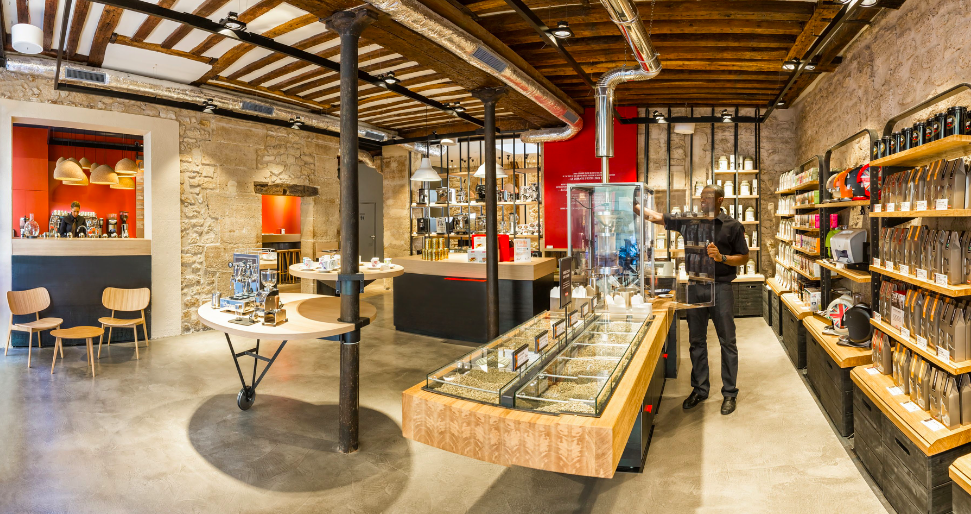
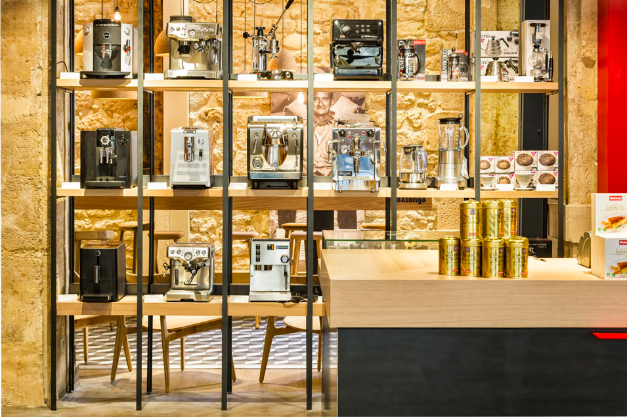
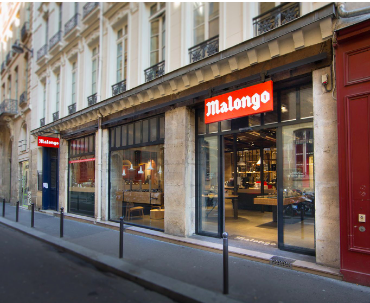
Two years ago, this battle horse was still wild, difficult to ride. Today, all agencies and advertisers wish to display this green flag. Greenwashing is still present, but is declining, the consumer can’t be fooled! And the environmental crisis is real; we can’t lie to ourselves anymore.
The same way there is a duty of citizenship, there is a duty of design. In each creative thought, the designer should integrate the 4 “R’s”: reduce, reuse, recycle and refuse; while asking himself at each step, from drafting to realization, “is it profitable or impact-free for the environment?”
The role of design agencies is no longer to simply provide a creative response to a brief, but to anticipate and bring together experts in order to better support their clients in designing more respectfully.
We have a duty and responsibility to design sustainable spaces, objects, and furniture with the most positive and responsible footprint for our future generations.
It requires a different approach to the matter; it also requires restraint… It implies daring, questioning, stepping out of one’s comfort zone, making choices, even if it means giving up. To help us, a lot of new materials are emerging: they come from the sea (oyster shells, mussel shells, seaweed), from organic waste (orange peel, coffee grounds…), from mushrooms, from textile waste… Some of them are not yet operational for ERP projects (establishment receiving public), others are still quite expensive, but it remains positive. As time goes by, the hummingbird makes its nest. Diversity is such, in these new materials, that it offers an infinite field of possibilities, an extraordinary creative wealth, a fantastic playground for designers.
Our teams have also had the pleasure of playing with these materials to create different zones with different atmospheres during their collaboration with Cojean, in the reinvention of its restaurant located at the CNIT in La Défense, Paris.
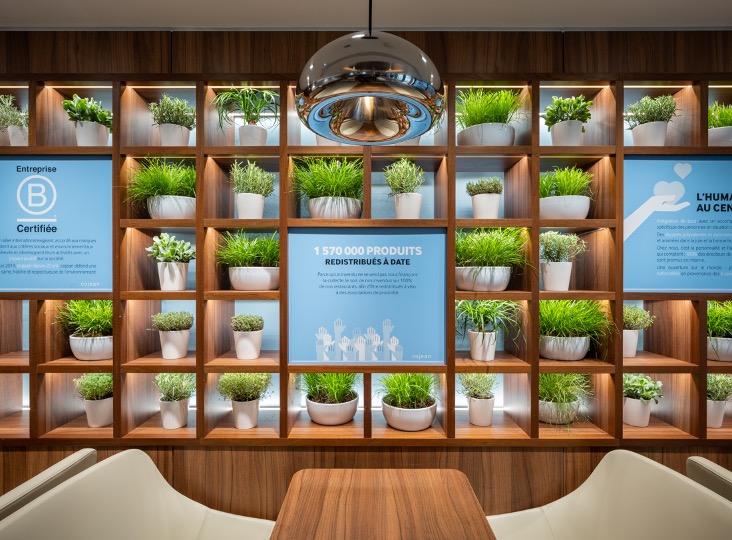
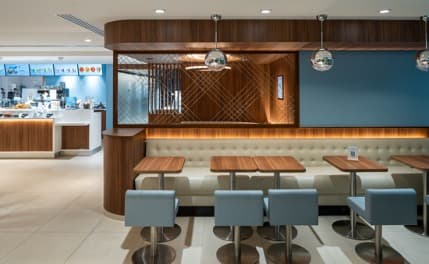
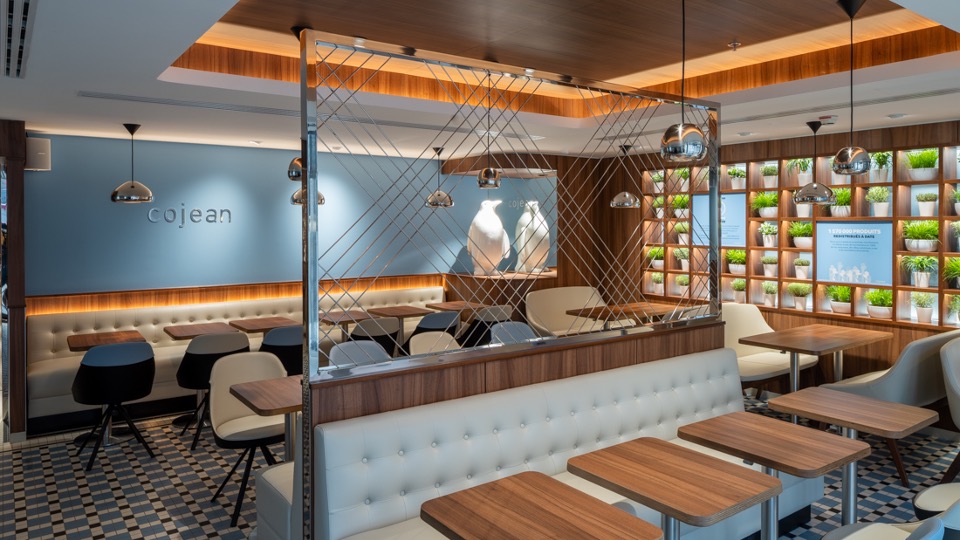
And vegetation in indoor spaces? Frenzy! We’ve always needed to remain connected to nature, long before the COVID era. However, keeping real plants alive indoors comes at a cost and requires maintenance, so we have a solution: installing plastic or stabilized plants. Why use real items if you can have artificial ones? The human being, once again, is not fooled, he does not wish to be in contact with anything artificial, he expects authenticity, as in its relationships. Even if the artificial plant is made from eco-friendly materials, this artificial flora has a carbon impact. Should we continue to create and use forgery to replace what is real if it is unhealthy? Here again, we must apply our duty of restraint…
Alternatives are available to us. Indeed, vegetation can be displayed in other forms: through illustrations, large format photos, scents, colors, materials; which also have a carbon footprint, you might say. So what can we do to avoid the immobility of the rabbit caught in the headlights of a car? Today: do the best you can, analyze, weigh the pros and cons and don’t hold back on imagination so that the future is joyful and caring.
– Corentin Nicolas, Executive Creative Director Retail & Architecture,
At CBA Design Paris
It would be complicated to define a brand by a simple definition, as it can have a multitude of meanings, both at the legal, marketing and economic levels. At the legal level, a brand is “a sign used to distinguish the goods or services of a physical or moral person from those of other physical or moral persons” since an order from November 13, 2019. However, nowadays, a brand represents much more than that.
If a brand is a distinctive designation, it is above all thanks to its set of unique signs: from its name, its logo to its graphic charter… These various components allow it to be recognizable and to act as a reference point on sometimes saturated markets. But it goes far beyond graphic elements, a brand is also an identity.
An identity that we recognize and with which we, as consumers, can identify through brand values, a vision, an engagement, a story…
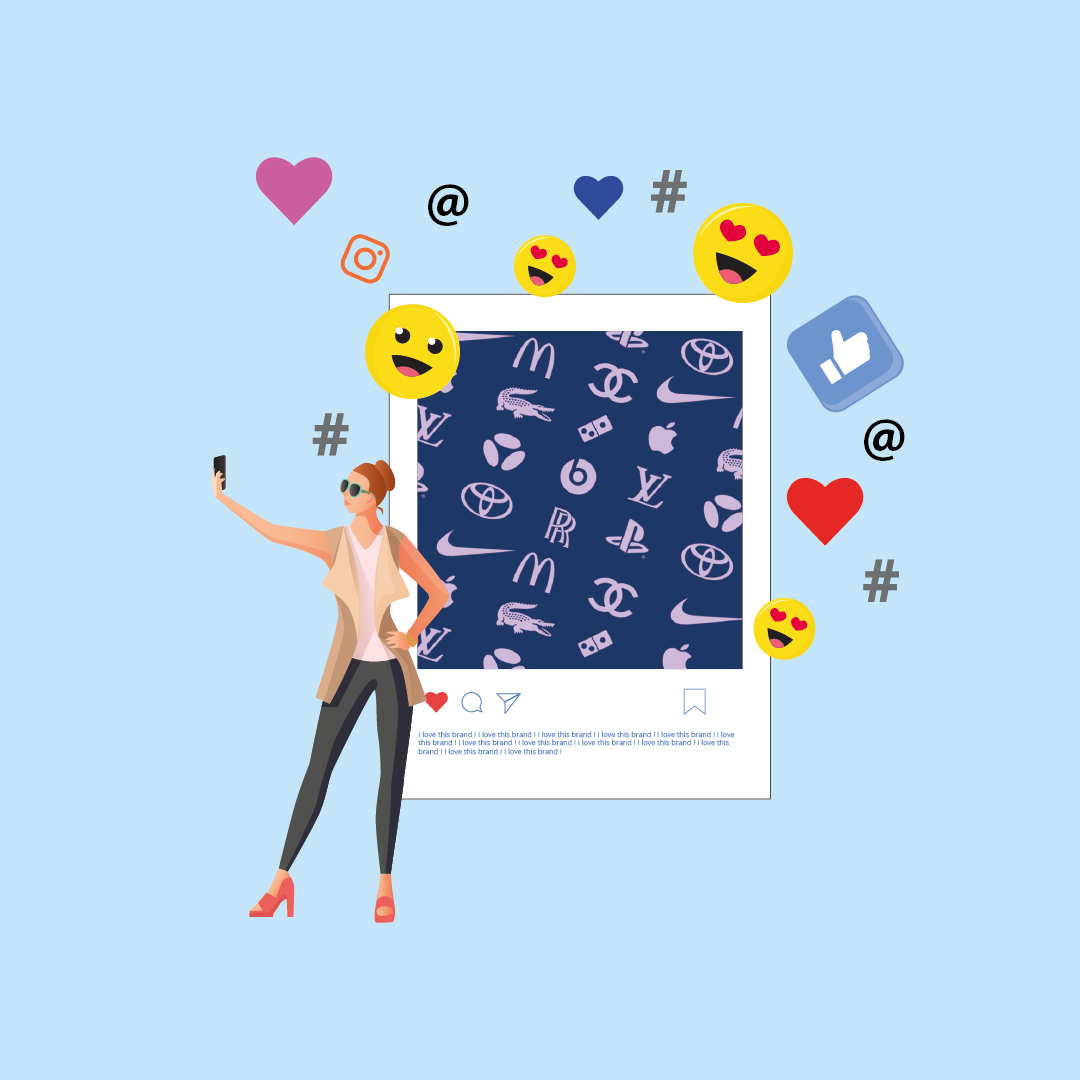
What would be an article about humans and brands without talking about influence ? Not much. Beyond a brand which influences our behaviors and buying habits, who has never been influenced by a celebrity or public figure ?
For a few years now, we were able to familiarize ourselves with the terms of influencers and influence. Influencers take many forms, they can be medias, celebrities on social media, people who actually become famous thanks to social media et many others. Today, an influencer is above all a person who, thanks to various platforms (press, social media, videos, radio…), is going to make of his person an opinion relay, in order to influence the consumption habits of its target. Influencers therefore become brands as soon as they are able to use from their image to influence, or even sell.
At a time where us, consumers, are more and more invited to identify ourselves to physical persons -the explosion of influence marketing is proof of this-, the question is : in fine, are we brands too?
Brands aren’t the only ones to have an identity of its own. Everything that surrounds us has one, whether it is an object by its design or a word by its meaning. But identities that are the most common to us, are probably ours.
As humans, we all have an identity of our own. An identity which distinguishes itself from others by multiple and various characteristics, by values that stimulate us, by a history and many others… Finally, characteristics that can be found both in human and brands.
From this simple observation, we can therefore think that in reality, everything is a brand, including us.
Let’s get to the heart of the matter… Have you ever heard about personal branding ? If this term does not ring a bell, there is a 100% chance that you have already practiced it. We talk about personal branding as soon as you try to stand out and be recognized in a professional environment. Personal branding allow us to develop a clear and effective personal communication strategy about our professional identity.
When looking for a job for example, you will for sure need to communicate on your person, put yourself forward as much as possible and try to “sell” yourself to recruiters. Sell your skills, your experiences, your story… It is in this sense that we can think that we all are brands, because we promote ourselves daily, as we could do for any other product that we can found at the supermarket.
What about our LinkedIn profiles ?
The famous social media where professionals meet, LinkedIn, is one of the pillars of personal branding.Yes, everything is happening on the web and on social media nowadays. We create a profile, which we feed with our experiences and our story, with a large part of our life in a kind of way. We try to get ourselves know, publish posts, share posts which coordinate with our values and what we love.
In a way, through all this and thanks to LinkedIn, we get a platform to grow our brand and make our identity known as a professional but also as a human.
Do you consider yourself as an influencer ? An influencer doesn’t need to have an audience of thousand of people. One person is enough to become one. Whether it is with our entourage or colleagues, we all are influencers. We don’t realize this on a daily basis, but we all use from our image to influence. Probably not in the monetary sense that we directly refer to the job of an influencer, but in the sens where we share our identity and opinions to our closed ones. We all have, at least once, recommended a product to a relative. Influence is also this. And as soon as we are influencers, we are also brands.
We can conclude that everything around is a brand and, as humans, we are too. Because through everything that we are, everything that represents us, we share distinctive elements and values, which originally constitute brands.
So, do you consider yourself as a brand ?
In the previous issue, we explored the idea of empathy, and wondered how it could help companies understand their target audience and find meaningful insights, close to reality. Between storytelling, direct conversation or immersive experience… a lot of tools allow brands to connect with consumers in a natural way. At CBA, we are convinced that technology is one of the most effective tools for understanding the uses of everyday life.
The VR technology uses a headset to place the spectator in a virtual environment with a 360 view, providing a more intimate and active immersion. For some people, technology is undoubtedly the best way to step into other people’s shoes. Technology has been used in games, science and arts, to recreate the way autistic people perceive the world, and as an invitation to reflect upon the effects of global warming.
At CBA B+G, we have devised for Nestlé a VR Project – Consumer Connections – to immerse in the lives of the target-consumers of three major brands of the company. One of the project’s expectations was to give everyone in the company – regardless of work department or position – the possibility to get to know the daily lives of people from different realities. The tool made it possible, for example, to follow a typical day in the life of Luiza, a teenager who lives in São Paulo and loves KitKat and skating.
To Cibele Rodrigues, Research Manager, at CBA B+G, “the project was enriching and powerfully delightful. It refreshed the target, putting everyone on the same page. Moreover, we escaped the traditional reports, showing more humane journeys. At the end of the day, the figures made more sense, allowing executives to take more assertive decisions, closer to the consumer”
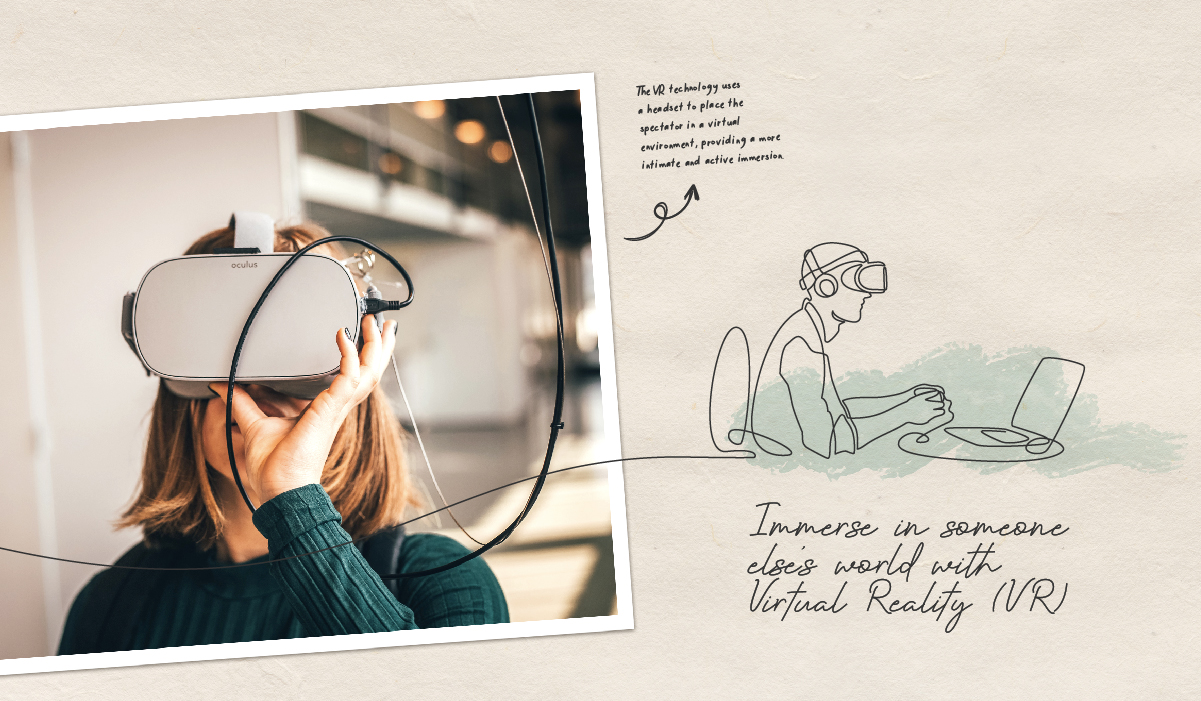
The immersion project using VR was one of the most incredible we have ever experienced, which made us think ‘why haven’t we done that before?’ The possibility to follow parts of consumers’ life is the icing on the cake for any insight or marketing professional. The approach was fundamental to make us understand the best moments and ways to connect with them
Demer Santos, Consumer & Marketplace Insight Manager, Nestlé
AR has also been gaining space in our lives. This technology make it possible to mix elements from the virtual and real worlds with the advantage of being much more accessible, since it doesn’t require a headset and can be easily developed in an app. It has been largely used, both by entertainment games (who remembers the Pokémon Go fever?) as by brands that provide a product trial without the need to leave home. That’s the case of Ikea, that simulates how your sofa would look in your sitting room; or L’Oréal, that offers the possibility to virtually try on different lipstick colors before choosing one.
But how is augmented reality used in research and Innovation? We have recently developed, together with one of our business partners, an app that used AR in a disruptive way, to make a survey about absorbent pads products. Consumers were able to try different shapes and sizes of new products, simulating real use by projecting them in their panties or bikinis.
To Alex Espinosa, “technology allows prototypes and products to reach millions of homes without the need of physically producing any of them, in real-time tests that result in products that better fit the target-consumer. It is the fastest and most effective way to validate your MVP (Minimum Viable Product) with consumers and find the added value and possible improvements within minutes”.
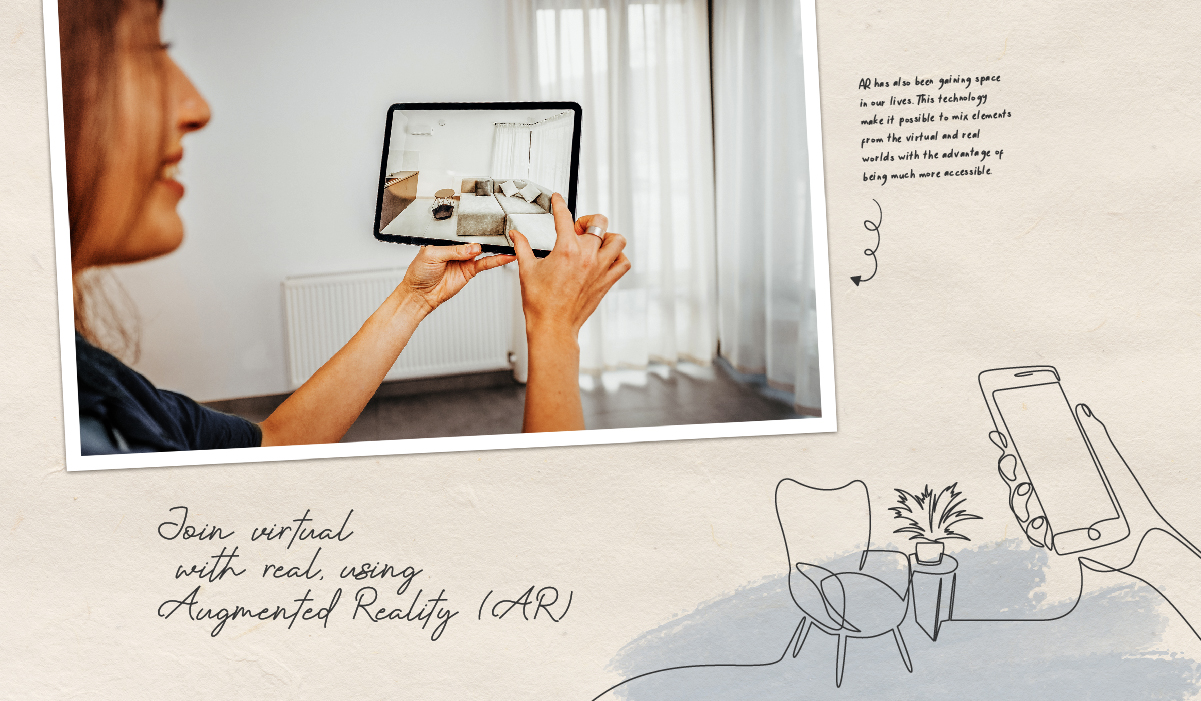
<p size="10pt" empathy
We may safely assume that extended reality will continue to evolve and improve to achieve astounding results. We bet on the use of Augmented Reality and other hybrid formats that explore the best of technology to project reality as perceived by others without disregarding human contact. Definitely, digital and analog realities are complementary in capturing insights more sensitively.
To delve into this issue of empathy and its tools more deeply, we recommend watching the TED talk by the Australian philosopher Roman Krznaric about how to start an empathy revolution, as well as the New Yorker’s beautiful immersive animated short-documentary film about detention camps in China. If you don’t have a VR headset or cardboard yet, it’s worth buying one and start playing with these new possibilities.
This article had the contribution of: Carmen Beer, Ana Cerqueira, Giuliana Sanchez, Thaísa Miyahara, Ana Paula Moreno, Alex Espinosa, Cibele Rodrigues, Demer Santos, Mônica Fernandes, Josy Lamenza, Daniela Irrazabal, Rosario Maglione, Renato Storni and Luis Bartolomei from CBA B+G
With the rise of digital, and more specifically of social media, a wide range of solutions and tools have been developed, allowing brands to become more embedded in consumers’ daily lives. Those who succeed in being integrate in a natural way thank empathy offer valuable insights on their uses and consumption habits, thereby transforming the way they are perceived by brands.
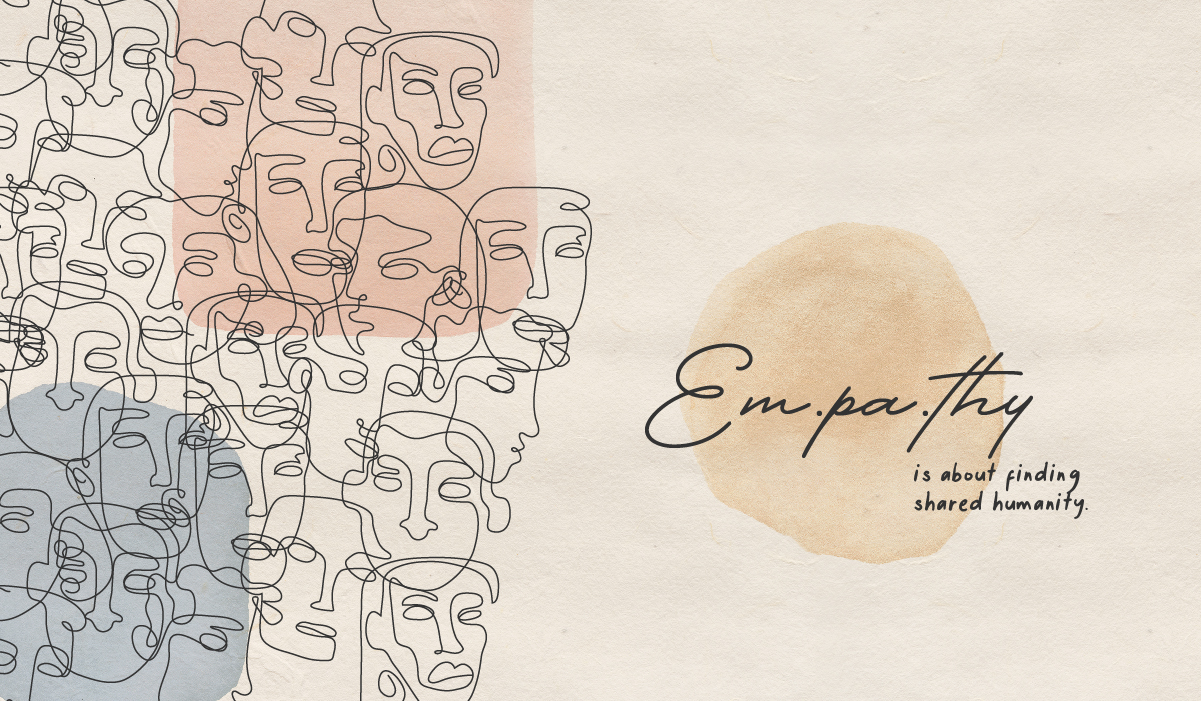
In the day-to-day life of big corporations, agencies or consulting companies it’s easy to forget the target consumer’s reality. Although consumers are on the core of everything that is done, thought and designed, oftentimes stakeholders know them through figures and reports, but rarely see them in flesh.
It is a challenging task to make consumer insights known outside the CMI (Consumer & Market Insights) department and engage more of the company’s staff in the process of understanding the target consumer.
Today there is an increasing tendency to value big data and artificial intelligence – which we, at CBA B+G, totally support. However, we can’t forget the great value of building emotional and human ties throughout the research and innovation process, by using tools that promote an empathetic immersion in the lives of consumers.
But what exactly does empathy mean? According to the Australian philosopher Roman Krznaric, it’s about finding shared humanity. He believes that we are urgently in need of empathy to create the ‘social glue’ to hold our society together. From a business point of view, empathizing with consumers is not only ‘cool’; we believe it also leads to transforming, effective and positive results, in three different ways:
Storytelling is at the heart of any empathic process, and there are countless tools, non-digital, hybrid or completely virtual which engage the spectator in the story in a simple, touching and impactful way. Here are some tools and examples that can be applied to society and by brands.
If empathy means to step into other people’s shoes, then why not literally do that? That is the proposal of the initiative called “A mile in my shoes” from the Australian National Maritime Museum, which invites visitors to wear shoes that belong to other (real!) people and listen to them telling parts of their stories. In São Paulo, the exhibition “Diálogo com o Tempo” (Dialogue with Time), hosted by Unibes Cultural, has created an immersion environment in the universe of old age, inspired by the same principle.
At CBA B+G, we have applied the same idea during an Innovation workshop held for Plenitude – a brand of disposable underwear, designed for people who suffer from incontinency. We have asked the participants to wear the underwear for three days, to put themselves in the consumers’ shoes and better understand their needs.
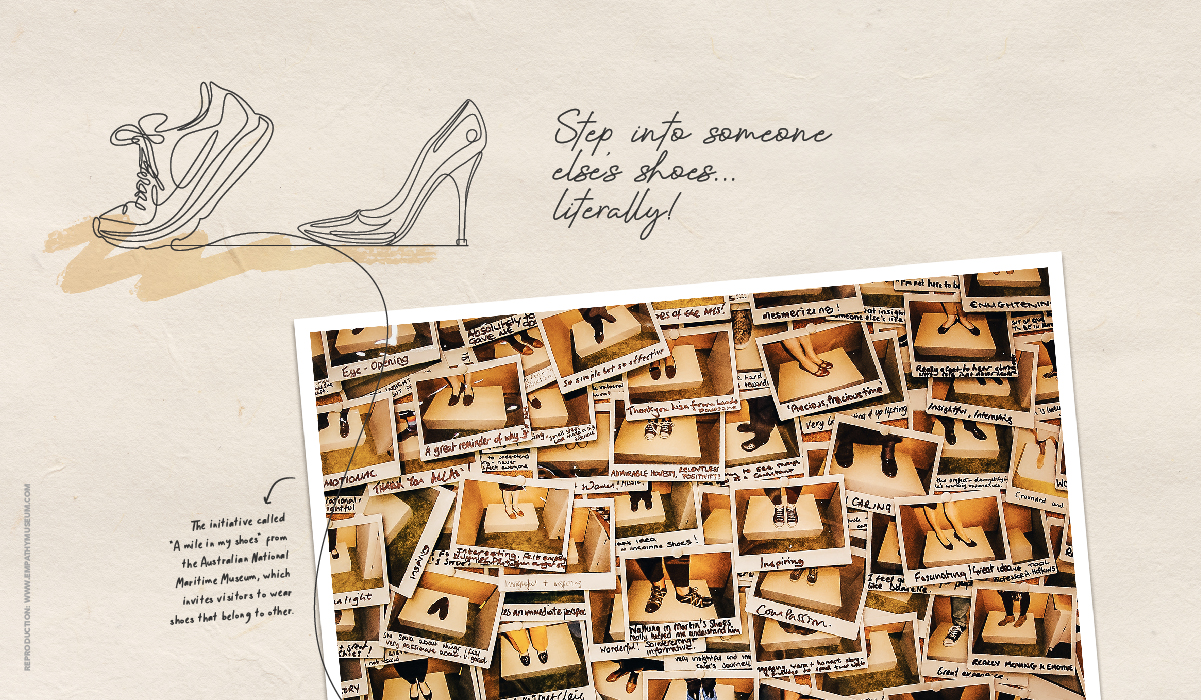
Using the product myself was revealing. We have always focused on absorption, however I noticed opportunities to go beyond. These insights led to new innovative attributes for the product, which are currently being developed by our Engineering team. Today we are close to offering one more benefit to better meet our consumers’ needs
Mônica Fernandes, CSI Adult Care Leader, Kimberly-Clark
Films and photographs are powerful empathy devices. This thought led the Chinese artist Ai Wei Wei to create the film “Human Flow” to raise global awareness about the refugees crisis. Brands also make use of empathetic films to create impactful campaigns. “Thank you, Mom”, the most successful campaign in the history of P&G is really touching because it effectively puts spectators in the place of mothers, creating a strong sense of identification.
At CBA B+G, we have been running ethnographic surveys and online diaries about consumers’ journey, asking them to film moments of their lives using their mobile cameras. For one of the partners we work with, from a hitchhiking app, we used the methodology ‘fear accounts’, through which we kept in touch with the app users via WhatsApp during a week, asking them to send us an audio each time they got scared when using the service, telling us what happened and how they felt.
This method allowed us to capture real and touching stories, spontaneously.
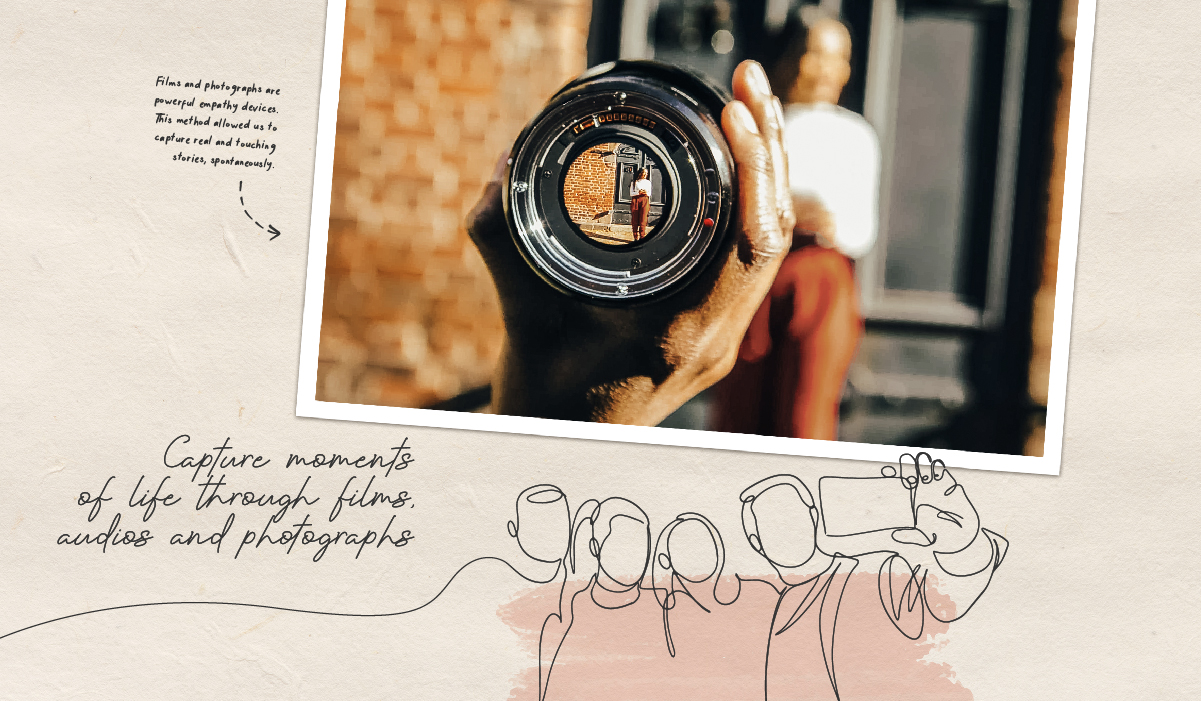
Who says we cannot mix consumers and clients, spectators and artists, experts and laypeople? Breaking these barriers is also a powerful way to connect people and develop empathy.
We introduce this concept during our processes, joining clients and consumers to work face-to-face, without one-way mirrors and with no condescension.Today, we do the same remotely.
Alex Espinosa, CBA B+G’s managing partner and Head of Innovation, explains that the objective is to “create ecosystems where clients, consumers, mentors and experts co-create together with a common purpose, enabling a multi perspective view of the challenge and incorporating experiences that boost the developed solution”.
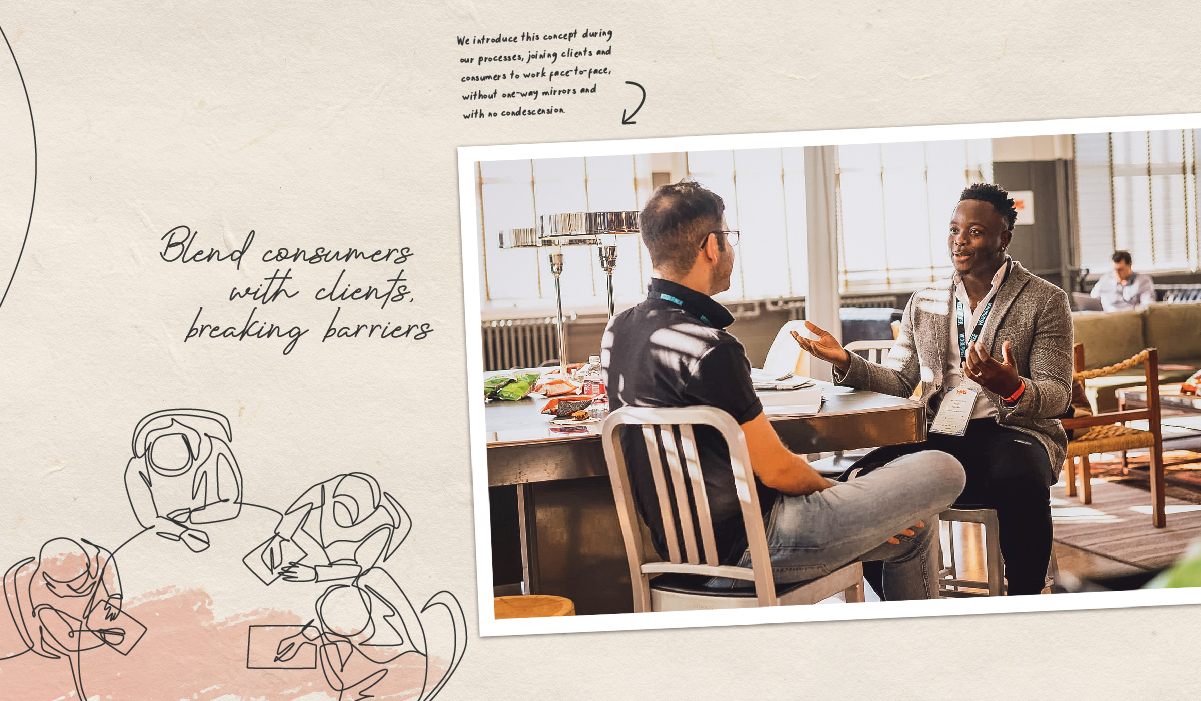
Many other tools allow companies to adopt a more empathetic approach with consumers and thus build a more emotional and human relationship with them. In the next issue dedicated to empathy, we will explore together how different digital tools, such as Virtual Reality or Augmented Reality, could be effective solutions to better meet the needs of targets and formulate meaningful insights.
Cet article a pu voir le jour grâce à la contribution de : Carmen Beer, Ana Cerqueira, Giuliana Sanchez, Thaísa Miyahara, Ana Paula Moreno, Alex Espinosa, Cibele Rodrigues, Demer Santos, Mônica Fernandes, Josy Lamenza, Daniela Irrazabal, Rosario Maglione, Renato Storni and Luis Bartolomei.
On the occasion of International Women’s Rights Day, we gave a voice to the women who bring design to life at CBA. Today, we wanted to go further by asking ourselves the question of the influence of gender in design. And yes, if design had a gender, what would it be? Do female and male’s influences differ that much? And what is the final impact, on society, on uses?
Men have always had an important, even dominant, place in the world of design, echoing their place in society. Although some female artists have stood out, offering innovative creations, especially for their time, the most famous architects and designers remain mostly men. Thus, the majority of the products and services that we use on a daily basis were created by these gentlemen.
Having always had the monopoly, one can wonder if they ask themselves the same questions as women do. In terms of ergonomics, safety etc. men and women do not have the same life experience, the same culture and often do not have the same education, not to mention biological differences.
The impact of the male influence is such that products and services tailored primarily to the male gender are still found today.
For example, let’s talk about car: even if less affected by road accidents, women have 47% more risk of being seriously injured, 71% of being slightly injured and 17% more risk of dying than men. ** The reason? Crash test dummies have long been based on male builds. Therefore, the design of the belts and airbags did not take into account the difference in mass and muscle distribution between men and women, which can be fatal for the latter.
The automotive industry is not the only sector where gender has an impact on society. The same goes for furniture and architecture in general. In 1945, the architect Le Corbusier conceptualized the Modulor, a universal silhouette making it possible to design the structure and size of the furniture. The only thing, this silhouette was imagined on a male build of one meter eighty-three, which is far from the female standards, whose average height is equivalent to one meter sixty. Another more recent example: the current trend is for smartphone screens larger than 4 inches, in order to make the most of multimedia content. However, according to a study conducted by Strategy Analytics *, women would prefer a smaller screen, around 3.5 inches; ergonomic logic, knowing that most women have smaller hands than men.
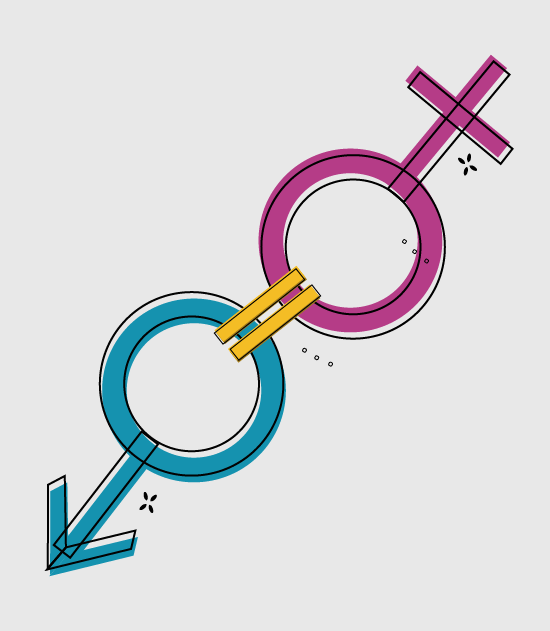
But make no mistake, not all designers have come up with products that are only suitable for men.
To name but one, Henry Dreyfuss, one of the forerunners of inclusive design, set out to put the user at the center of his designs. “Let’s keep in mind that this object that we are working on is going to be used by people, individually or in mass”, he said. Considering that a design project must be able to integrate all social, ethical, aesthetic and practical requirements, in 1955 he published a book entitled “Design for people”. He was not the only one: many other male designers are showing design innovation. Victor Papanek, a pioneer in eco-design, has dedicated his life to promoting responsible design for the planet and for society. Speaking of society and inclusion, did you know, for example, that some everyday products were originally designed for people with disabilities? This is the case of the remote control, an idea of Robert Adler, which was to be intended for bedridden people unable to move around to be able to change channels.
In terms of design, as in marketing, we find for most products, a separation: there are those intended “for men”, and those “for women”. We observe the same thing with the famous: “pink for girls, blue for boys”. Where did it come from? Did you know that a few centuries ago pink was the color of boys? Indeed, since antiquity, the color pink was rather attributed to men, because it was considered a sub-color of red, which at the time, symbolized power, authority and war. Blue was for a long time the color attributed to women, in reference to the blue mantle of the Virgin Mary: it symbolized purity. It was at the end of the Middle Ages that this fashion was reversed, with the Protestant Reformation, blue became a symbol of gods and strength, and red became the symbol of love and femininity. It was in the 18th century that the Marquise de Pompadour, who had fallen in love with this color, would have made it fashionable in clothing but also in decoration, which would have made pink popular for women.
But ultimately, does this gender classification really define design? Not necessarily. We have seen that fashions and influences change at the same rate as society evolves. Male and female influences are unique to everyone, depending on their personal experience. There is no longer any question of gender separation. For some time now, fashion has been “no gender”, and more and more brands are investing in this niche. This trend is influenced by the changing codes of society: according to a study published by the advertising agency Bigeye, half of Gen Z and 56% of millennials believe that the binary value of gender is outdated.
As a result, more and more brands are deciding to follow this trend: many toys are becoming gender-neutral, with neutral colors in order to break out of this restrictive dichotomy. The same goes for the fashion or cosmetics sector where a certain number of collections are made unisex.
A more “gender neutral” youth and why not freer, in its choices and its own influences.
One by one, social stereotypes are being deconstructed. Inclusion and compassion are not just about women, logic and reason are not just about men. It’s not the gender but the experience and approach that will create the design; and it is mostly the people, the personalities, the eras, the visions and the genius of each one that allow progress.
Does design have a genre? And if the woman had an influence in the design, what would it be? Whether a muse or an artist, women have always been present in the world of creation and design. Although they has long been in the shadow of men, what is it today?
With the rise of feminist movements and the fights for gender parity in society, we questioned the place of women in companies in France. Although actions, such as the equality index, have been put in place, these represent today (2020) only 18% of management positions in our country *. Of course, gender diversity is more and more accepted, standardized, and demanded in different fields, but women are still too rare when it comes to leading. (Since Isabelle Kocher was disembarked at the beginning of February from her position of Managing Director at Engie, there is no longer a woman at the head of a CAC 40 ** company).
Design has long been a man’s business.
Women more often than men tend not to feel legitimate in certain positions of responsibility. The world of design is no exception. Indeed, design has long been a matter of man. In fact, the most famous designers have often been men; women having been completely excluded until the 1930s. A phenomenon that could be explained by the following fact. Women have long been seen as simple housewives, unable to understand the business world and run a business or a team. Another explanation could be that of “impostor syndrome”.
However, there are exceptions! Some women still manage to find their way in this world long dominated by men. Ray Eames, Charlotte Perriand or Florence Knoll. These names mean nothing to you? Understandable. These are women who, despite their talent and skills, have remained in the shadow of men. For example, Charles and Ray Eames have long been thought of as two brothers. Now, Ray is a woman. And what about the furniture designed by Charlotte Perriand that was signed Le Corbusier? But still, you surely know the Nike’s swooch ? One of the most recognizable symbols in the world. It was also created by a woman. And no, this is not the achievement of one of the brand’s co-founders! The artist’s name is Carolyn Davidson; yet, still too few people know her name. And finally, let’s talk about the Knoll furniture publishing house, inspired and founded by Florence Knoll, and not her husband. It is important to keep in mind that in the 1950s, when women were supposed to stay at home, a young woman like Knoll was able to build what is still the biggest furniture publisher today! If this has been possible, it is because all women can do it and, above all, be legitimate to do so.
The stories of these women remind us of how important it is to fight for your passions. These design pioneers, who at the time were not rightly regarded for their work, are now among the most recognized female designers.
So, to all future generations of designers, DARE!
But then, beyond the place of women in design and their positions of responsibility, do the latter influence creations? Can we, with the naked eye, recognize a feminine creation from a masculine creation?
Emotions have always been considered a gender marker. The men are in the reason, the logic, the pragmatism while the women have a more sensitive and in fact more intuitive approach; which will make them more inclusive and emotional in their approach. However, one is not better than the other. What makes design so interesting and powerful is the combination of the two influences: sensitivity and pragmatism, emotional and functional, compassion and logic. Creation is therefore an act that goes beyond genre. When you are a designer or a creator, there is necessarily a more important dimension of sensitivity, which goes beyond the genre. However, when the council looks at more technical, performance-oriented design registers, there may indeed be more men, such as architecture. We can then wonder if this is related to emotional creation versus mechanical creation?
So, the question could be: does the genre has an impact on the perception that the designer has of what surrounds them and what feeds their inspiration, on their approach ultimately? A designer is someone who observes the world around them and who responds to issues. The world around us does not look the same for a man as it does for a woman, so they tackle different issues.
A concrete example: at the end of the 1940s, Charlotte Perriand invented the open kitchen; why the kitchens should always be relayed to the back of the house, isolated? House in which the woman would only have the right to appear with the finished dish. With an open kitchen, she can cook, chat with friends and family, have a glass of wine, etc. A purely design issue that a man might not have thought of; and it is in this sense that the genre has an influence. This influence will allow women to be more attentive, especially to brands, which are more collaborative with consumers and their customers.
The future of women in design looks bright and promising.
The future of women in design therefore promises to be flourishing and very promising; even if it will always be a rocky road. This notion of resilience that women have, this courage and this selflessness make them forces capable of creating designs that are more respectful, more durable and more human. We have gone beyond the demands, and arrive in a logic of appeasement, and recognition of the strengths of women, without comparison. A balance, a complementarity.
Fighting today goes way beyond what it was even a few years ago, and is gender-neutral. At the moment, society is moving at high speed on the issue of gender. The new generation takes up subjects with greater heights, focusing their struggles on equity and diversity. In addition, there are more and more collective movements, led by women, which are flourishing, in all fields. These collectives will make it possible to break these glass ceilings. Women, just like men, will finally be able to show their talents and be recognized for it.
Thus, female influence is therefore present in the approach and analysis of a problem. But in the end, the expression is done in the same way since all designers are passionate about their profession and sensitive by nature.
In short, the design is therefore non-gendered.
And, because design is a mirror of society, and society is multi-gender, it must address all targets, and all walks of life.
* Source France TV info : https://www.francetvinfo.fr/replay-radio/c-est-mon-boulot/seulement-trois-femmes-sur-120-dirigeants-dans-les-plus-grandes-entreprises-francaises_3838909.html
**Source Europe 1(https://www.europe1.fr/societe/les-femmes-grandes-absentes-a-la-tete-des-entreprises-du-cac-40-3950352)
The resilience of territories is an omnipresent subject, to which we, citizens, are all confronted and sensitive. For the past year, we have been questioning the role of policies in territories and their resilience. The growing mistrust of them might suggest that their impact has been minimal; and yet mayors have a level of trust twice as high as the government.
Additionally, as a branding agency, we believe in design as an element of positive transformation. Since 2017, we have been convinced that the successful brands of tomorrow are those that will place people at the heart of their approach, embody a cause and have meaning, to leave a memorable mark beyond what they sell. Indeed, beyond local elected officials and mission-oriented companies, brands can also become actors.
They will always keep their primary economic role: to create jobs and to have an impact on the purchasing power of consumers. But they have the ability to go beyond their primary purpose and thus have a key role to play. A support role but also a driving force. Why? Because they are anchored in a principle of reality that brings them closer and connects them to citizens. This allows them to act as a support but also as a motor, a mirror of society. In addition to their commercial value, they participate in progress through innovation, their discourse, pedagogy, and give consumers the means to act.
Is it out of opportunism? Altruism? Obligation? And finally, what is left? Is purpose ultimately the basis of everything? This is not yet another story on the subject but to ask the question of the role of brands in the resilience of territories.
Some brands have transformed at the pace of consumers. They are anchored in a principle of reality that brings them together and connects them. They bring them a notion of dreams and pleasure by making their daily lives easier and by being more attentive to their needs. Indeed, there are those that adapt to the desires of consumers, without neglecting emotional value and pleasure. Those that meet their engagement needs. And finally, those who try to combine it all.
It is these useful brands, with a sufficiently rooted and embodied purpose that have a role to play in the development of territories. As a brand, how not to get lost in the twists and turns of its existence? How to elevate its utility beyond a simple functional response? How to impact the territories by developing sustainable and accessible solutions? Questions to which a few brands have already answered thanks to the consistency of the evidence and actions attesting to their purpose.
It is these useful brands, with a sufficiently rooted and embodied purpose that have a role to play in the development of territories.
Blablacar, whose mission has been declared since its creation “The good for all”, has demonstrated its agility and its contribution to the resilience of regions, thanks to the creation of its Blablahelp application: a service that connects neighbors in order to support and to support people who are isolated. A surge of solidarity around a community already well established and in perpetual growth, allowing the brand to have a significant impact on the territories and legitimacy to take part in them.
The startup Né d’une seule Ferme has also contributed to progress. The brand’s mission is to enhance the profession of farmer, by providing them with fairer remuneration, while promoting farms through the creation of the first national multi-local brand. Unique yogurts with a taste specific to each region.
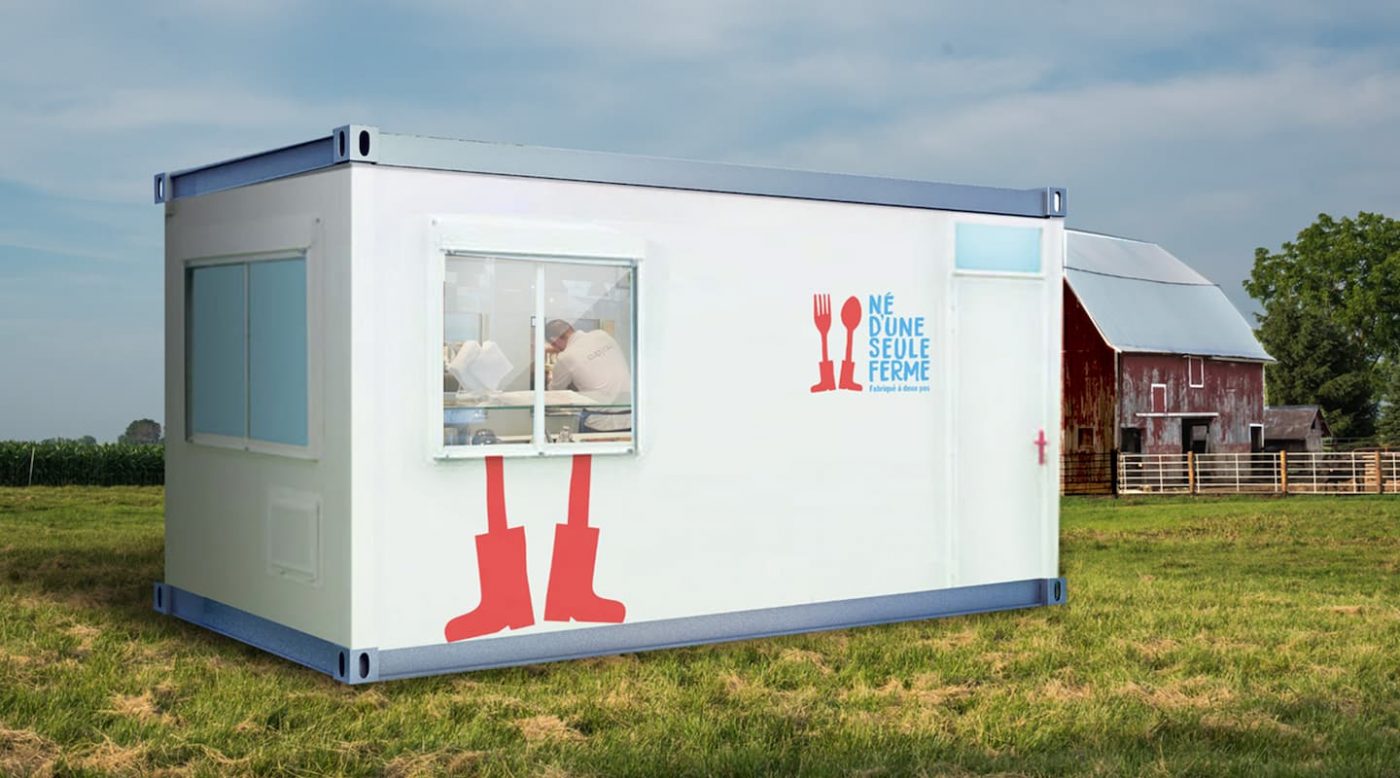
In short, alongside citizens, local actors and governments, brands also have a role to play in the resilience of territories and more generally in their environment.
This is not just an exercise in style or tendency: it involves rights and duties. Having an impact on society, and therefore gaining relevance to local issues, requires honesty demonstrated by thoughtful and consistent actions. Without this, the actions taken by the brand may be perceived as opportunistic, thus diluting its impact through lack of consistency.
These are levers of action in the resilience of territories.
your purpose ?
Where our consumption patterns are doomed to change, the agri-food sector also has its role to play. How? ‘Or’ What ? By developing the concept of Sustainable Food.
At CBA, we are proud to support brands and companies that bring meaning and constantly seek to improve their practices. Come and discover some of the brands with which we have collaborated in the development of projects that promote Sustainable Food.
Through design, we advance their Critical Imprint.
For this project, the CBA teams created:
Since then, the identity of Maggi Marketplace has been rolled out in several key markets, such as Germany, Australia, France, Poland and the Netherlands.
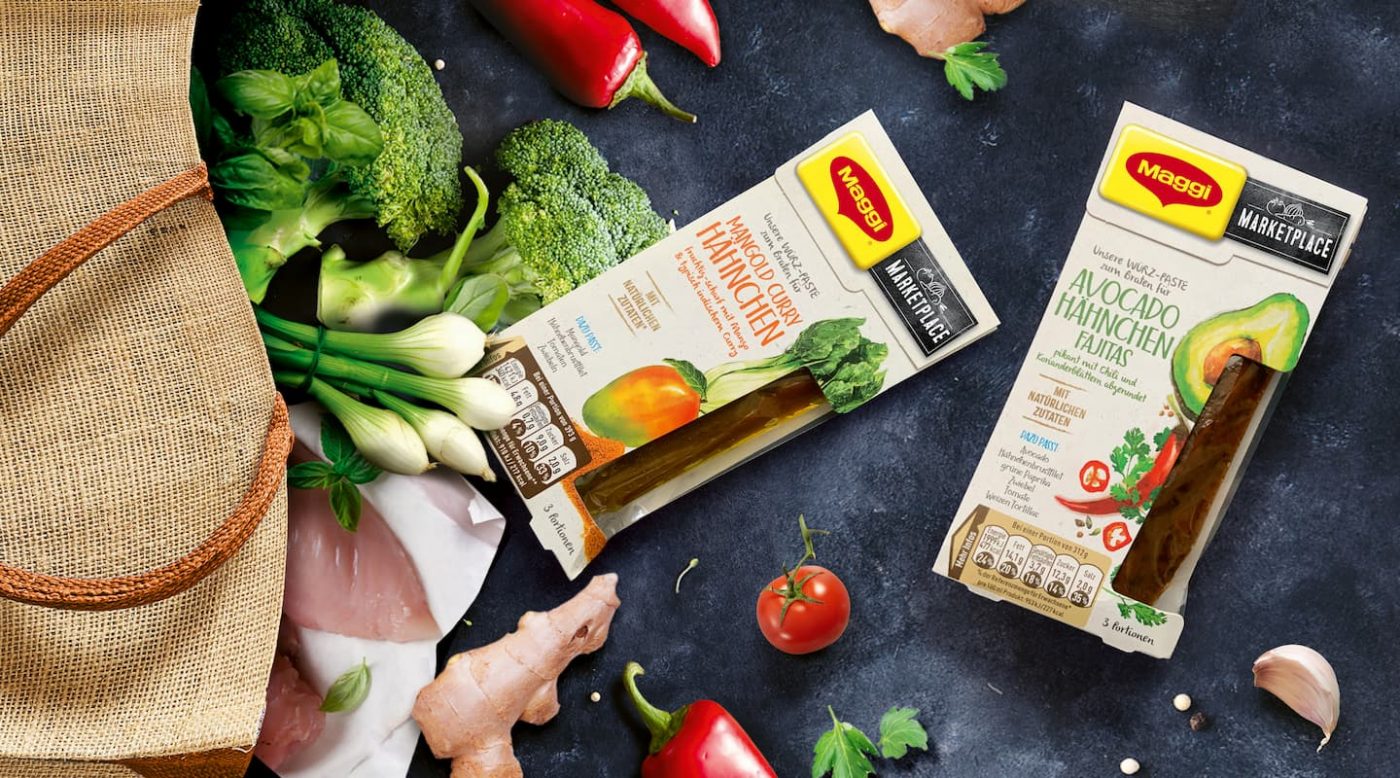
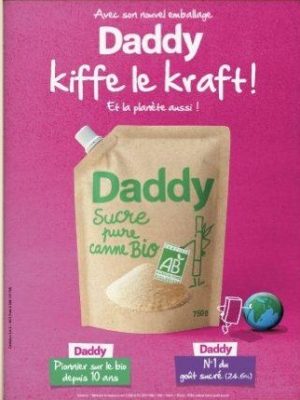
Today we have repositioned the Daddy brand by deploying an iconoclastic and atypical differentiation strategy driven by packaging design, innovation and activation.
Since November 2019, the cane sugar range has been offered in doypack packaging made from 100% recyclable kraft paper, with a new design for better emergence on the shelf.
Concretely, a project that reconciles meaning and utility for this historic brand!
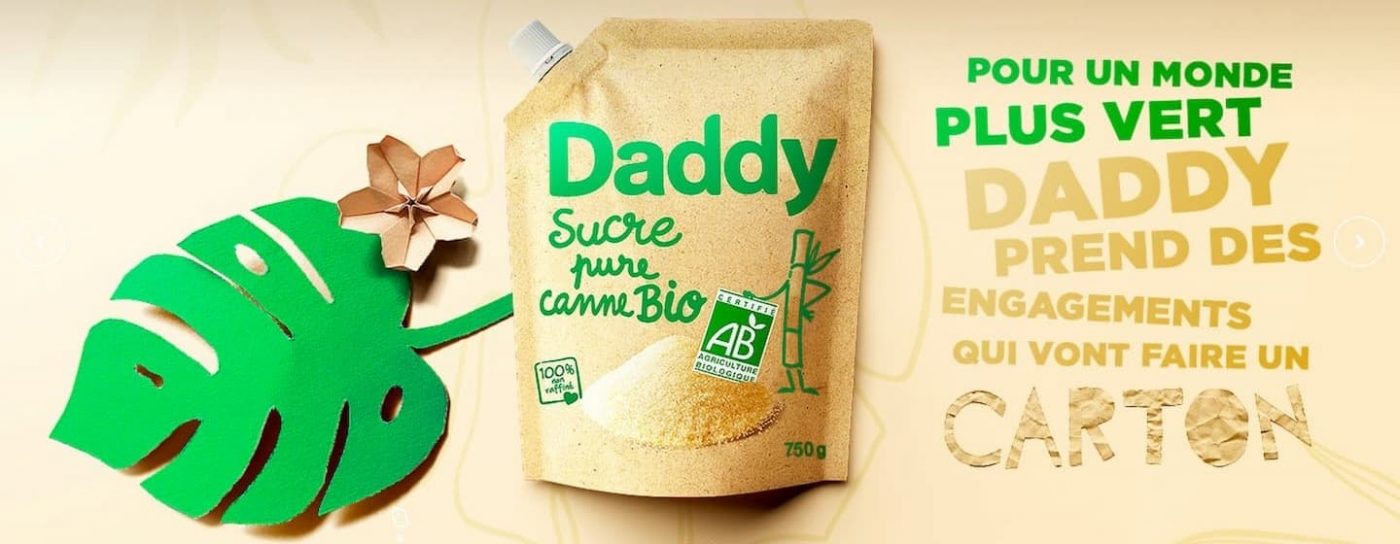
Good Goût is a brand created in 2010 by parents who wanted to reinvent the “baby food” category.
In collaboration with a Chef, they were able to launch small dishes for babies, around 3 strong and ambitious drivers: the Good, the Beautiful, the Organic.
The company called on our teams to develop dialogue between the brand and parents through the logo and its brand signature.
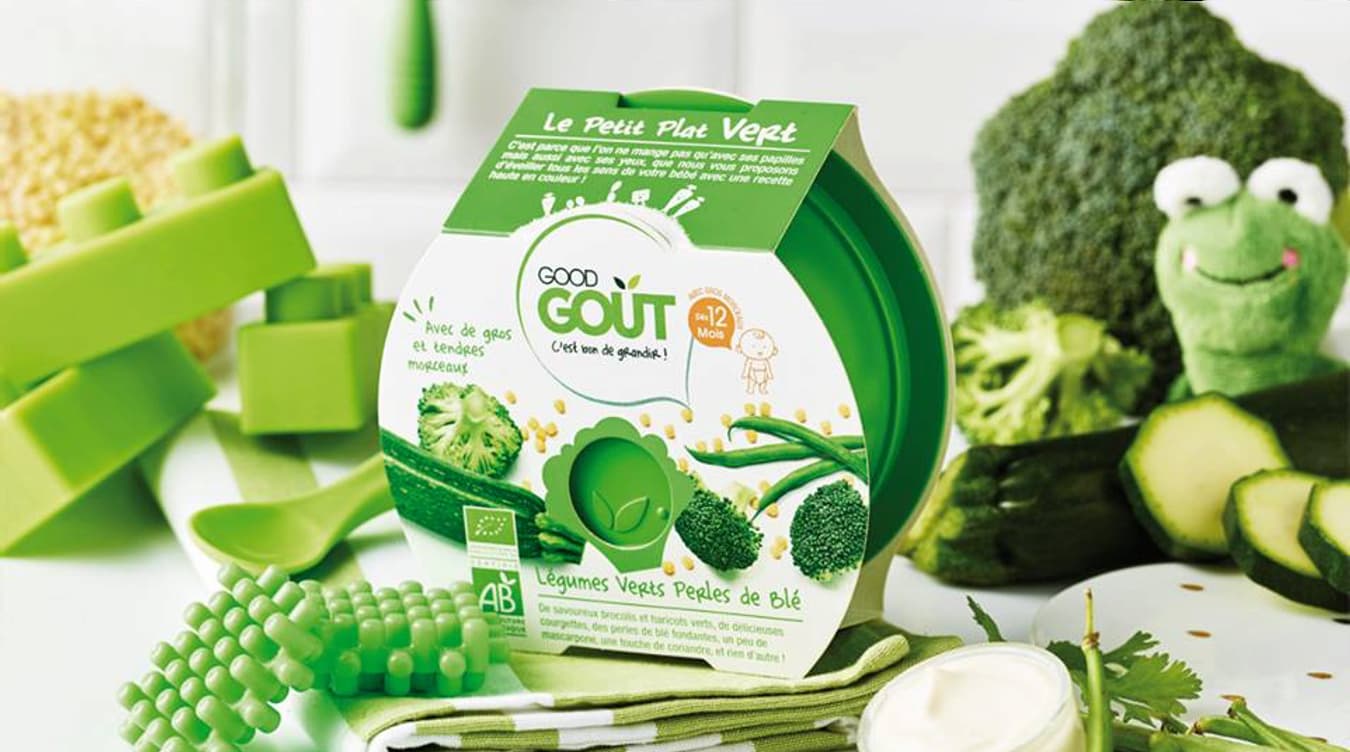
Secondly, for babies who have grown up, the agency created the graphic register for the Kidz range.
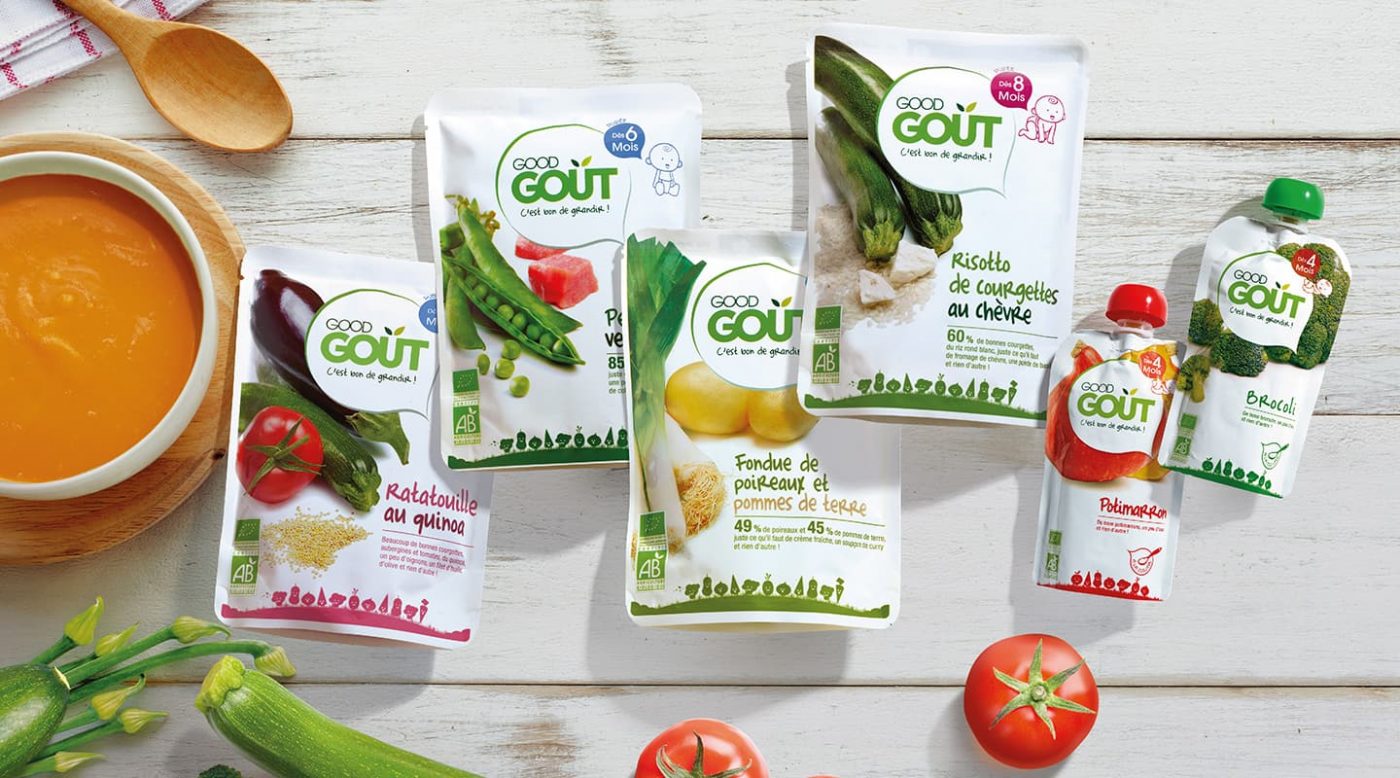
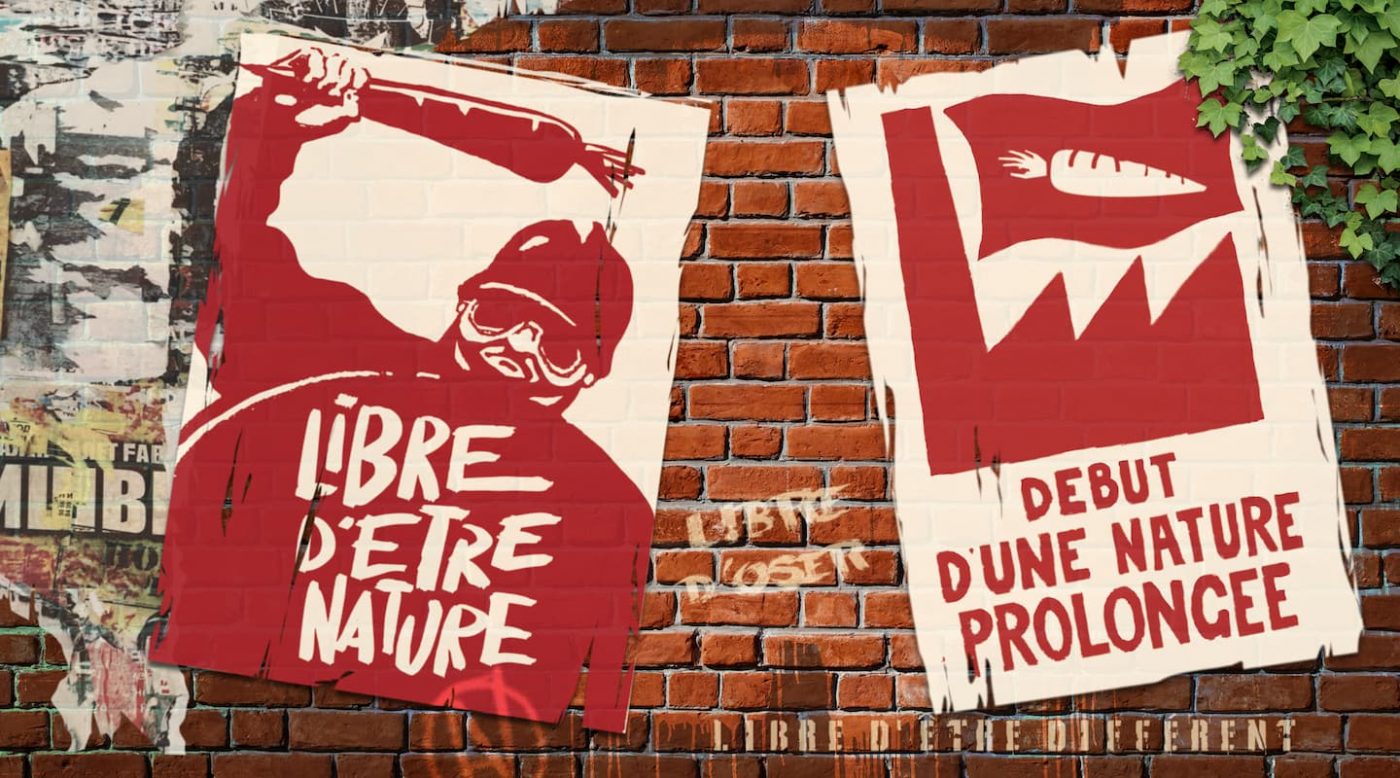
Finally, we take you to discover Naturalia! Centered on pillars such as responsibility, transparency, diversity and daring since 1973, the brand is committed to offering an organic alternative in the heart of cities.
Naturalia called on CBA for a global overhaul of its identity based on its original values: a brand that advocates the freedom to live organic in its own way!
The graphic concept is based on the brand’s DNA that is bold, unconventional and transparent; concept that fully contributes to increasing Naturalia’s Critical Imprint.